This 15.5 x 10.3 cm notebook is bound in brown leather with the border embossed: the brass clasp is intact. The front of the notebook has a 6.8 x 2.5 cm cream-coloured paper label with 'Buenos Ayres. St. Fe and Parana Cordillera of Chili' written in ink. The paper is marble edged. The end pages are marbled. Some pages have a watermark "W. Brookman 1828". A string is tied around back hinge clasp and a piece of string, c. 2 cm long, is stuck through a hole which extends through all pages up to 60a. The notebook has 234 pages. The first sequence of 233 pages starts from the inside front cover towards the end (1a-233a). The second sequence is five pages from the back cover inwards (1b-5b).
[front cover]
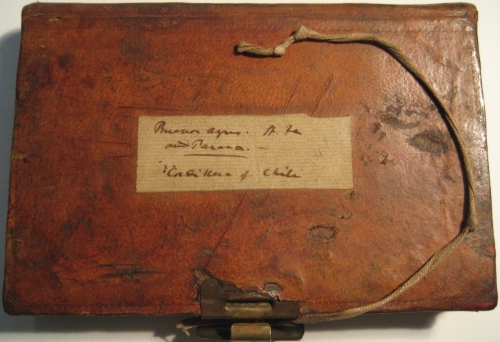
Buenos Ayres. St. Fe
and Parana —
Cordillera of Chili
[inside front cover]
[page 1a]
[page 2a]
[page 3a]
[page 4a]
Mr Lumb
338 Peon for B Blanca 406 or
2800 silver Harris
58
100 Peon to St. Fe.
C. Fitz Roy & 630
Stokes
(for horses first 25 stage) Tailors bill Passage of Covington
Dixon [Price] & Jars & Box
[do] Valparaiso Money
Recon [agent] M Video
Endorsements John Gouland
Katers Compass Compass
[Terallos] letter Fleming
watch 117 [Big Hat] [Turtle]
Peon (86) 7 / 6 before starts for Books?
Silver Rials
[page 5a]
Tailor, Shooting Jacket mended. & Trowsers: Big bag: Lindsay Calle Piedad.
Big bottles: Large Clasp knife. 130D [Protractor]
Bees wax Rosin. Corks for Jars Hargrave 55. Piedad Steadman 30 Cathedral Field sports [Prairie] Ch. Grandison1 2 dollars Mr Loudan Mr Lumb 28 [Caypur] denture mended2 Stirrups 58
7 406 5 90 7 630 80 5 400
7 2800 Jar for Molitas Market fish: Write Bills Pen knife Repair the book Mr Tweedee [seeds] Paper for plants: Tow: Bladders Cotton: Woollen Stockings Bottle small with large mouth: Gold Leaf. Mice & Rat Traps Blank silk handkerchief Pills Druggist. Bishop [Reconquesta] opposite church museum see petrifactions Mr G chart of B Blanca French Survey of River [new chart] 1832 Calle Piedad Watson Wood Snuff Box Mackintosh [Water] + Washing bill: Seeds of grass. Mr [Flint] [Tylor]
1 Richardson 1781.
2 On Darwin's teeth see Colp 1977, p. 135.
[page 6a]
Wood chopped by axe
J Britain direction Sending map
Snake Mr Hind Snake Lindsay
Indigo French Bookseller
Gunpowder & shot: Note Books Chili Letters Letters from Mr Hooker Grand Seco1 ??? Snuff to M Video Gun
Formation Sugar. Bread. Cigars
At Corrientes Letters of Recommend If possible paper. (brown) soft: obtain them money clothes. passport 30 leagues up Shells in cliffs
Great Seco Load Pistol
([From] In 1828 for 3 years supposed one million died in the Province)
1 Spanish name for the great drought of 1827-30 which caused the deaths of vast numbers of cattle on the Pampas and an explosion in the numbers of mice. Hearing of it made a great impression on Darwin, who referred to it in Natural selection, p. 181.
[page 7a]
Water not fresh above 50 miles Island Marineras.— Laguna de los Patos About 50 miles from the mouth
Said in the country where no Capincha fear of Jaguars: not occur S of Plata :
Biscatchas drag things to holes
At Punta Gorda. Matanza [Cat]? Barquin: Limestone: Hard rock at Mr Hooker Estancia
Megatherium found at R del Animal Paper for Plants. M: Video
[page 8a]
Captain Robertson Part of Copiapò — Wasko Cliff beach of Shells Hill like [bubble] Quiloata; 2 men deserted from Conway: Abingdon, Gallapagos.— Sail-maker Frezier. 1715 - translated by Dr Halley.1 South Sea
1 Frézier 1717.
[page 9a]
Friday 28 27th [September 1833] —
passed Capella Moron & slept on the about 3 leagues from Luxan great bed 6 leagues of young thistles; same Gaucho with Head: Biscatchas run badly like rats. tame: infinitely more numerous than to South:
no geology except on surface apparently pale hard Tosca:
Started not before 1 oclock
Saturday 28th [September 1833] —
passed Luxan on river by bridge nice church & Cabilda. from thence to Areco smaller town. country generally flat
[page 10a]
yet there are great inequalities; for from some places very large horizons are in view — nearly whole country thistles & clover: miniature forest clumps — rise green out of the very dust. — few birds. whole country Estancia: distant one from other: — Passed R Arrecife — on barrells. & slept rather unwell yet paid for 31 leagues
[page 11a]
In several places, saw pale & red Tosca, with a very little mortar: Luxan & Areco Rivers
Sunday 29th [September 1833] —
About 7 leagues North of R Arrecife: well in reddish Tosca, with some Mortar country bare, as road, thistles not having sprung up: Biscatchas drag rag bones & thistle stalks to their holes.
In evening first saw Parana at distance. Woody Islands: at St. Nicholas large straggling town
Many of the brooks in whole journey paved with bones of horses & oxes
[page 12a]
San Nicholas on river: large schooner & vessels. many islands with bush & Entre Rios tambien: barranca 30 or 40 feet high.
perpendicular Many sorts of Indian figs. chief change in vegetation: cliff pale Tosca, horizontal variations in colour & hardness & some Tosca rock no mortar; For future Pistol in hand: not leave guide: —
Monday 30th [September 1833] —
Both Bahia Blanca birds; Sparrow, small pidgeon, & scissor bill stay whole year build in marshes all this near
[page 13a]
St Nicholas; the road whole day, very near the river, camp very level, with precipitous valleys, cliffs red, lofty, 50 or 60 feet: Rozario on a point close to river striking appearance very many bushy Islands, bushy & Entre Rios. do: striking view: camp with few thistles, good grass: many cattle: new trees mimosa, more flowers: Rozario nice town, level plain hospitable man, found pistol stolen: Peon very weak: today only 20 leagues: yesterday 24: Colegio St. Nicholas, striking
[page 14a]
looking from large Church, in very fertile & flat plain: passed Arrozo del Medio & entered St Fe: much reddish Tosca with little Tosca rock: Aroyo del Pabon very much Tosca rock: precisely resembling that of R Salado Tapalken, impossible not to recognise same formation: some with very numerous serpentine cavities lined with black, others much harder & semicrystalline V Specimen: this rock
[page 15a]
forms pretty cascade of about 20 feet plenty of water: Aroyo Seco same geology Aroyo Saladillo, I saw the phenomenon of rapidly running brook with brackish water bank with Acanthus thistles: I do not much like the Inhabitants; civil d—d rogues: The views of river; 3 or 4 miles across very different from anything I have seen, from number linear shape if islands not like lake Barrancas most picturesque:
[page 16a]
Tuesday 1st October: [1833] Our sleeping place I think had very bad people: started by moon-light & arrived on coast of Carcaraňa by sunrise: cliffs composed of pale, da Tosca with very many Tosca rock stalactites: above it layer with small Tosca concretions marked with manganese, & above it earthy very soft sandstone: in the former there was a large rotten tooth & in the layer large cutting tooth: Procured fresh horses & started for the Parana view quite pretty lake scenery: found two large straggling deposits
[page 17a]
of immense bones of Mastodon.1 V Specimens. very rotten in perpendicular cliffs, heard of many other bones: when it is considered that these are only sections of an immense plain, how very numerous these animals must have been: at Parana barranca: bottom pale yellowish clay with curious numerous ferruginous cylinders above great bed (50 feet in [whole]) of earthy reddish, stalactite & nodules of Tosca rock
1 A type of extinct elephant.
[page 18a]
numerous, especially in lower part: in this part were the bones sticking out of cliff — returned by noon to the house & started again: Cormorants at Parana & many beautiful new birds. I think sea birds enter the camp more readily from its openness: scissor bill eat fish, no mud banks, sit on grass camp, as on mud banks: BB Bird at Cordova: Biscatchas place dung bone &c on flat above
[page 19a]
entrance of holes: are abundant where no thistles: All four Armadilloes at Cordova Peechy Port St [Elina] Passed R. Monge, brackish as the Carcarana; but little:
Camp north not so dead level, yet regularly uneven: never [saw] camp, but with different length of horizon arrived at good Estancia at Sunset:
Wednesday 2d [October 1833]
Unwell in the night, next to day feverish, & very weak from great heat: every thing shows the great change in
[page 20a]
small change of Latitude dress & complexion of men: Oranges & gr immense Ombus beautiful birds & flowers. reminded me of Brazil: About 3 leagues south of Coronda entered the [Montes] Home Guardia Monte, flat diluvial plain with Mimosas, lawn scenery, took Escort — Indians, saw a dead one in road & Estancia desolated
[page 21a]
This forest extends some leagues South of Coronda took Escort (in this part Indians). — Lopez other day killed 48 Indians in an Island
— (Tyrant) Time of old Spaniard (no)
Coronda prettiest village I have seen; from many Ombus & oranges.
Saw simple Top fashion of spinning. —
Crossed in a canoe
[page 22a]
a Riacho1 & arrived very much exhausted at Santa Fe: obtained an empty room & bed & made ourselves tolerably comfortably. —
Thursday 3d — [October 1833]
Very unwell in bed: — Santa Fe kept in very good order, large, straggly, every house, with Garden
1 Spanish for a narrow arm of a river.
[page 23a]
Town looks green & clean
Friday 4th [October 1833] — Unwell in bed. —
Saturday 5th [October 1833] Crossed over to the Bajad passage of about 4 hours, winding about the various Riachos generally as broads as the Severn & much deeper & more rapid gave me a great idea of size of river: at last crossed blowing fresh. the main stream: saw
[page 24a]
several large vessels one which drew had drawn 17 feet water had entered: Barrancas [high] 60 70 or 70 80 feet at least. muddy water Continually falling covered with luxuriant vegetation, picturesque: with humming Birds: Town very straggling, but rapidly increasing from fine position [of Province]: half a league from the Port, on account of Paraguay Indians formerly:
[page 25a]
Sunday 6th [October 1833] Much better. rode to the bottom of cliff; lower great bed pale yellowish earthy clay; this rest on horizontal or variously curved strata of butiminous clay or sand, deposited by streams, in [some] [case] the vegetable [films] are visible. V Specimen in others not: the clay bed contains few shells in irregular layers chiefly of two 3 sorts. V Specimen. it contains also plenty of Gypsum: Above this is a great bed of limestone more or less pure when
[page 26a]
pure Crystalline, when less so containing vast number of large ostrea, few Pectens1 impression of Terebratula & other shells; also very few pebbles of coloured silex: certainly fragments of big bones & fish bones: above this occurs the lime becomes very impure with many ostrea, Above this great bed (½ altitude of all) of reddish earthy Tosca
1 The scallop Pecten sp., a bivalve.
[page 27a]
in lower part in has a bed of aluminous [calcareous] concretious masses with manganese V Specimen like at M Hermoso to which Tosca resembles, also few smaller concretions in upper parts: in some case beds of yellow indurated sand in this Tosca: As far as I recollect Tosca rock a[t] Pabon resembles that at R. Tapalken
[page 28a]
Monday 7th [October 1833] — Walked to the Barrancas, found myself much tired. Quantity of Limestone varies, exceedingly in some parts nearly absent — In one place fine white sand above Limestone: all beds subject to change: — Found black Epeira, amongst bushes in society of some hundreds (all same size ∴ age) main threads very strong common to many vertical webs. each web one or two feet from the
[page 29a]
other: spider black with ruby marks on side of back:1 Saw a largish (running spider) Shoot several times very long lines from tail, these by slight air not perceptible & rising current were carried up-wards & out wards (glittering in the sun) till at last spider loosed its hold, sailed out of sight the long webs lines curling in the air:
1 See Journal of researches, p. 42.
[page 30a]
clearly two sorts of Megatherium to found at Carcarana & Arroyo del Animal cotemperaneous with Mastodon: case of latter two or three inches thick: The Limestone at Punta Gorda (I am told) de- is near waters edge: Shells are found at R. Hernandrias, & by Brooks a valley is known to run across the country: country west of Santa Fe all low: In Entre
[page 31a]
Rios Biscatcha — Molita Paluda
Tuesday 8th [October 1833] Thirty thousand Inhabitants in Entre Rios 6 in the Bajada. 1825: Beneath limestone bed there is other one of greenish fine greasy (Magnes) Clay. where dry exfoliates & shrinks & falls. then limestone falls & is worked: bed about 12 feet in some places resting on the yellowish sandy clay:
[page 32a]
Wednesday 9th [October 1833]
Delayed by bad winds, very timorous navigators: weather most oppressingly hot at 8 oclock at night 79 outside house, with many fire flies: Pleasant idle time extreme hospitality: one of few men I would trust :
Thursday 10th [October 1833] —
Blowing a gale of wind from the South most unwillingly delayed another day:
At noon went to see some of a Paludas case
[page 33a]
in a Barranca of red Tosca, one league East of town on R. Tapas, which enters R. Conchas. — Tosca with calcareous & Tosca rock concretions: The shell formed a case well between 4 & 5 feet across entire, but soft no bones except a lump: the bones were said to be less than full grown cow. — very many bones in various parts of Barranca, chiefly small
[page 34a]
Excepting one large piece of shoulder blade: —
Unquestionably this bed is above the Limestone: In one place found tooth of horse in red compact Tosca & well buried, it being a Horse, only cause of doubt of real position, after long examination, I came to conclusion that that the Tosca might have been washed down
[page 35a]
& rehardened; but not very probable: the Barranca being inclined precluded the final certainty of the question: How wonderful number of bones — Great bone was not well covered yet I think belongs to Tosca: Smooth surface of Casca internal: (Saltpetre in Entre Rios) with shells & gypsum Marble at Cordova & Modern Formation
[page 36a]
The House rat of Maldonado is very common here, in out-houses: crawls much in hedge — 6 mamma on each side, the third is placed as far distant from the 4th — as first from third:
Friday 11th [October 1833] Indolence of the master did not start: great misfortune to me: in evening went out shooting procured specimens — Oven bird called Casara or house-maker how
[page 37a]
well is BBB called Casarita:1 Captain F. Certhia here: yellow breasted Sylvia do: Callandria:
Saturday 12th [October 1833] Started Gracias a dios: Tosca above Limestone divided into two beds, lower one pale, other upper bright red. ½ gale of wind in our teeth: beat amongst the low islands, at last fastened the bark to the
1 A bird, the 'little house builder', see Zoology notes, p. 158.
[page 38a]
trees of one. — I started for a scramble, two sorts of trees, commonest willow covered with creepers & other plants, swamps covered in floods, muddy sand: fresh & indupitable sign of tigre:
Sunday 13th [October 1833] Meat bad, fine fish 4 sorts, rain & gale whole day, in bed because cannot sit up: at Bajada red sturnus & common oriole, black & white fly-catcher
[page 39a]
then man informs me that a South wind here always clears weather as SW of B Ayres. — ∴ Current changes hence wind does not result from impetus but suction:
Monday 14th.[October 1833] — Ten thousand curses, wind yet SE & dirty weather: Many especially Maldonado one Kingfishers: & Cormorants: Rather better weather so that I could fish & in boat pull about the creeks: all pleasure in wandering about the Island
[page 40a]
is destroyed by fear of tigres. — in this journey main conversation rastro del tigre as before rastro de los Indios: met my Peon running at great rate, attack people in vessels:
Tuesday 15th — [October 1833] after some delays, so very cautious, we started passed Punta Gorda with its Indian colony chiefly red Tosca — with bed of Limestone at base. — Sailed quickly down stream amongst the intricate
[page 41a]
Islands: we came to anchor, (from foolish fear of bad weather in a narrow Riacho, I took the boat & proceeded up it for about a mile —
narrow with willow & creepers & winding, deep, slow stream the cry of birds & fire flies: saw to my delight scissor bill just at night
(perhaps at Laguna at Maldonado at day, because extraordinary number of fish) flying in that wild rapid manner as at Bahia Blanca & ploughing the water amongst jumping fry:
[page 42a]
Maldonado kingfisher builds nest in trees: Slept on deck on account of muskitoes & heat :
Wednesday 16th [October 1833] Started, with wind a beam arrived at Barrancas on West coast above Rosario: Barranca very even about 40 feet high, generally with irregular band of yellowish clay beneath as described at Gorodina: at Rosario with Tosca-rock: Passed the mouths of the rivers which we crossed generally near the Barrancas
[page 43a]
straight-backed fish1 — silver bands in back irridescent greenish brown — dorsal fin pale dirty orange — tail fin central part black — above & below [this] bright red & orange: — hump back fins pale orange — tail with central black bluish black spot behind branchiae silver band: — back colour do salmon.2 — blueish above gradually shading down on sides fin tipped with fine red especially tail but with black central band
1 Specimen 748 in Zoology notes, p. 178; listed as Tetragonopterus rutilus in Fish, p. 125, plate 23.
2 Specimen 747 in Zoology notes, p. 178; listed as Tetragonopterus abramis in Fish, p. 123, plate 23.
[page 44a]
Salmon1 grows to 2 or 3 feet long: sharp belly about twice along.
The wind not being quite fair came to anchor: thousands of muskitoes, difficult to sleep —
Thursday 17th [October 1833] —
Gale from SW & Rain. remained at anchor about 5 leagues above St Nicholas. —
Fish2 with low eyes, upper part of body & those fins with faint tint of yellow but stronger on head with dorsal clouds of black, tip of tail do:
1 Specimen 749 in Zoology notes, p. 178.
2 Specimen 746 in Zoology notes, p. 178.
[page 45a]
beneath snow white; sometimes little bigger; usual size pupil black, iris white not very common. Little Indian boy our passenger value one ounce:
Friday 18th [October 1833] — Night very cold, started early. Barrancas same height much broken down // Curious equality & lowness of society: sons of officers commandante of B.B. officers count as Representatives: general dishonesty. G. Rosas weighs everything one cannot understand it at first: // In great Seco many people lost 20,000. others less: brought live cattle to eat
[page 46a]
to San Pedro. Barandero — hundred of thousands carcases dead on banks (fall down barrancas) float in water: could not pass many of the streams for smell — it would be said some great flood had killed all, especially as after it all rivers were very much flooded corresponding deposit // Carranchas muy picaros,1 steal eggs // Almost Becalmed sailed on till 2 AM. Passed San Pedro at early night
1 Spanish for crafty, sly.
[page 47a]
Saturday 19th [October 1833]
Heard of revolutions: very little wind: Ennui
// yellow-breasted bird at Maldonado sings well //.
I should think the difference between Tosca rock & mortar is owing to the latter being nearer point of origin of Lime — Cotemporaneous with Gravel of South ∴not subsequent as not broken: ? The alluvium [not] extended cotem. with [part] alluv [rocks] of T. del F. I remember that the mortar on North side of great Escarpement North of Colorado — is Mortar not argillo-calcareous rock. //
[page 48a]
a little South of Arroyo Cruz great valley. greatest interruption I have seen in Barranca a mile or two wide doubtless connected with those which I noticed between Luxan & Areco. — This is the only vallies which are not immediately explicable & proportionable by present brooks: height of Barranca remains the same. — the river here leaves the Barranca on the Southern point of great valley
[page 49a]
Came to an anchor middle of the night, near the mouth.
Sunday 20th [October 1833]
Changed vessels, as the one which anchored near us drew less water, in this proceeded to the bar then changed again & proceeded a very narrow Riacho. — with many wild peaches & oranges on each side & some large black gallinaceous birds; tide being against
[page 50a]
us — hailed a canoe & proceeded to La Punta de St Fernando. —
There first heard of great revolution, could not take boat: went all evening from one great man to other great man & at last got permission in the morning to go to General Rolor's camp.
Monday 21.st [October 1833] —
Arrived very early at the Camp; horrible looking set of men. — Rolor traitor:
[page 51a]
got order to go to General chief. difficult to procure horses. — often obliged to show Licence: water over horses back. Arrived at rebel Camp. General Rosas brother at last got permission to go with a party with white flag to bridge. — from thence on foot leaving recon &c behind to proceed if I could on foot to the city, passed centinel by pulling out
[page 52a]
old passport & making circuits at last reached the city. — They are down right scurrilous set & the town is much alarmed about being ransacked. I am in bad predicament. my servant peon is out in the country with my goods. the vessel coming down the river has my collections one million cattle died in grand seco Salinas have inhabitants from Flamingoes. 30 leagues above Bajada shells in Cliff
[page 53a]
M Video. big bottles paper. cork, Iron rust 8 by 8 inches Spirits Bladders: Mr Maclean Capt. Fitz Roy write to Admiral Otway1 Specimen[s] [dentist] Wilson. Rector. Islington Bishop of Calcutta Price 2 & Dixon 1 Lumb. Valparaiso Chili
1 Rear Admiral Sir Robert Waller Otway (1770-1846), Commander-in-chief of the South American Station.
[page 54a]
Stevenson South America.1
Dolores names of Schooner in Bahia Blanca
5 dollarsStuart2
Measure big bottles
Cigars
Spanish bookseller opposite Mr Waldegrave
1 Stevenson 1825.
2 Peter Benson Stewart (1808-1864), mate on the Beagle, who entered the Royal Navy in 1822 and was promoted to lieutenant in 1837. CD spelled his name as 'Stuart' in the Beagle diary, pp. 10, 239 and 272.
[page 55a]
November 2d. [1833] With difficulty got on board packet, heavy musketry || General utter profligacy character absolute government, History of revolution: at night foul winds Many passengers: women & children all sick
[3d] [November 1833] Anchored in sight of Colonia 3d fowl winds, intelligent German
4th [November 1833] arrived on board, Beagle does not sail
5th [November 1833] Took up residence on shore
[page 56a]
6th [November 1833] Started early with party to St Lucia, swam the horses ¼ of mile passed on about 5 or 6 leagues. — came to Barranca 50 40 or 60 50 feet high: composed of coarse particles of white quartz from dust to goose shot in size loosely cemented, with narrow bed of clay in one part, no organic remains. Covered with reddish Tosca which contains particles of quartz
[page 57a]
& stalactites [&] plates, [forming] hexagons of calcareo-argillaceous rock rock evidently deposited where Tosca has contracted but the substance contemporaneous, because there are parts forming ½ the mass & beneath that without scarcely any. — It appears to cover the sandstone filling its irregularities: Is this Tosca same nature with B. Ayres formation. — the
[page 58a]
concretionary Tosca rock looks like it, but presence of quartz pebbles marked difference. It is curious never finding a fragment of bone — extreme modern from covering sand bed just like new forming beach of river. — Recrossed river St Lucia at sun set. & slept at a Ranch returned rested early to city
[page 59a]
Found gneiss cleavage near city running W by S & E by N M. Video Saw great Iguana kill large green Lizard1 — Molita at M. Video [regular] rocky soil: Tapalka Nest of bird shot by Maldonado lake; sort of B B Bird
1 Mentioned in Zoology notes, p. 381: 'I sent home a skin of a large lizard Iguana.— I know not its number. I saw it one day catch & kill a green lizard 7 or 8 inches long, & shake it like a dog'
[page 60a]
Dry beds of lakes of Coquimbo. —
Great earthquake of 1751 destroyed Concepcion?
The land rose. —
Shells found 500 ft elevation on Concepcion
English Dr at Mendoza has the head of a Megatherium.
Road to Coquimbo. Barranca with shells
Las Vacas gold-mine. Meirs Conchilee.
Uspallata plain 5970 ft. Meirs.1
The Canota pass from Mendoza. to Uspallata far most interesting:
R. Quinto bed. horizontal strata
(Cliffs at river of St. [Luis] & north of it
(Los Gigantes. — Traversia between San. Lucia & Mendoza —
Mendoza 2600 ft.
I should think Luxan village good section S. of Mendoza
Pass of Canota in the Paramillo. horizontal beds over the strata. —
El como de los [illeg]
1 Miers 1826, 1: 277. The following line on the Canota pass is also a note on this page.
[page 61a]
Castle Hill. — Calcareous & gypseous Tufa Incas bridge. —
R. de los Horcones much gypsum between Breccia. Paramillo de las Cuevas. some say. Volcano Red & green snow
M. Entre
|| Post house Pindo 1773
Santiago 1691
Post house Chacuturo 2139
Cuasto of do. 2896
Villa Nueva. 2614
Primera Quebrada 3215
Guardia 5148
Ojos de Aqua. 6874
Casucha1 of Juncalillo 7730
— — Calavera 9450
Cunha 11920
Las Cuevas 10044
near Estero de S. Maria 7928
W. foot of Paramillo de Juan polices on river bed 7380.
Small round towers with raised floors formerly used as storehouses by the Indians.
[page 62a]
Cuesta. Paramillo — 7888
Tambillitos 6250
Uspallata post house 5970
Villa Vicencio 5382
Mendoza 2602. —
D. Felipe Bauza1
Santiago 2620
Casa de las Calaveros 10603
— Cunha — 12709
— Cineras —
— Puquiros —
Mendoza — 4474
Leagues
Mendoza to Luxan. 5
Caracal 5
Estacado 12
Arbolera 3
Cenoza de Alvarez 4
Capilla 3
1 Felipe Bauzá (1764-1834), a Spanish officer and geographer who made a barometic survey in 1794 between Mendoza and Santiago. CD copied the heights of Santiago (St. Jago) and Mendoza into his Geological diary, CUL-DAR36.462v.
[page 63a]
Chacaro 4
Portillo 3 (ridge)
Los Puquenos 3
Casa de Piedra 6
S. Gabriel 8
Melacolon 5
S. Josè 3
Guardia 1 1/2
St. Jago — 9. 1/2
Total: 80. Spanish leagues
Santiago to Colina. 6
Villa de S. Rosa 19
Guardia de Resquando 13
Ojo de Aqua 5
Laguna del Inca 5
Calaneras 1 1/2
Carrula 1 1/2
Los Cuevos 1 1/2
Paramillo 1
[page 64a]
Puquiros 5 Punta de las Vacas 3 Uspallata 13 Villa. Vicencio 15 Mendoza. 15 Total 104 ½ leagues Chlorite slate. Colina !. Caldcleugh Salto de Agua Gold mine in Iron Pyrites on road to Valparaiso. — Limits of Traversia Tosca rock Cordonese geology: ask Mr Caldcleugh about metallic veins. — Caldcleugh Mastodon direction of Lamina of slate at St. Luis. — Proceeding in straight direction to Rincon on bank of river good section of St Jago plain — Badge — [Perfect] — Limit of snow Height of passes French: Naturalist Muscles near Mendoza
[page 65a]
Fox Biscatcha
Was the great wave which destroyed Concepcion quite sudden? —
Elevation of land at present day
I have to draw 261:2 at St Jago
2 dollars worth of [Iron]
Mr Smith — lake running E, W narrow but some leagues long. ran
wave about a yard high: gutters with same direction stopped running: —
If the land really does oscillate 20-30 ft effect very trifling —
Pencil note - Book some in town [illeg]
[page 66a]
18.th [March 1835] Rode over the burnt plain. Noticed clearly at the Almeira & Cuesta in front of St Jago, that the strata dipped internally, judging from large fragments, stratified greenstone worth examination. — Travelled till we came near the Maypo, struck up a not broad valley with high mountains on each hand. — Method of travelling &c &c luxurious water melons on road, provisions. Custom house civil on account of strong passport: pretty valley trees loaded with peaches bending & breaking with the weight — grapes nectarines & large apples. — Well within the valley, Cliffs of pebbles
[page 67a]
2-300 ft high appear to abut into valley as part of plain lowering higher up: river flows over bed of same. — On first entering the valley pap of fine-grained syenite; after this there came an extensive line of low hills composed of very fine white granite with black mica — These run about N & South & were capped by great mass of stratified red rock, dip East: certainly porphyritic Breccia we afterward as some distance crossed this rock, much of which was of a greenish tinge & materials much blended,
[page 68a]
in such a variety, I saw a band of coarse breccia about a foot wide. — Before however arriving at this, there was a rough track composed of semi-crystall. greenish Trappean rocks; part of which was slaty & what I have called "altered" generally however more crystalline parts slate coloured porphyritic with delicate crystals: I imagine this forms a subordinate mass strata between Porph-Brec. & granite — anyhow it is certain that the latter reposes & appears filled by the former: there was also
[page 69a]
a mass of high crystall-porphy-greenstone, the origin of which probably is distinct from the greenstones & altered slates. This is the very first range
19th [March 1835] In front of sleeping place a hill of soft, whitish brecciated rock, (A) & nature not certain, as we passed along there appeared a transition by the varieties (B) (C) (D) into a compact greens porphyry — hence I presume it is merely a variety in Porph Breccia, as far as I could see from stratification it overlies the more crystalline varieties; part of the latter was partially columnar. —
[page 70a]
our road turned for long time south & then about SE: on each side bounded by great mountains with very abrupt escarpements divided into many strata all I believe Porph=Breccia — the coarsest fragments 6-12 inches long, separate sooner than break, chiefly perhaps in highest parst [parts] — Strata shown by a more [stony] crumbly variety interposed between compact sorts of which (E) is specimen: Such wherever I could see, is the constitution, the strata are almost always inclined but not at great ∠ & apparently various direction, generally however the
[page 71a]
main valley, has 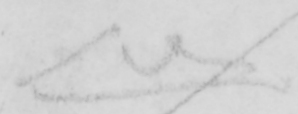 basset1 edge on each hand, in some, same dip on each side, but angle various; one ravine synclinal — I also saw two very clear mantle shaped spots. — In few places were there dykes: I saw however this structure
basset1 edge on each hand, in some, same dip on each side, but angle various; one ravine synclinal — I also saw two very clear mantle shaped spots. — In few places were there dykes: I saw however this structure
 [section showing dyke]
[section showing dyke]
where (at great distance, a rock appeared to have been injected: The Porph-Breccia immense thickness, the summit of mountain of S. Pedro Nolasko is composed of it — I judge from great fragments remarkable color & stratification. — Probably 6-7000
1 Edge of stratum cropping out (OED).
[page 72a]
ft: at least. — I saw one spot dip at about 50° — whole scene great scene of violence & subsequent excavation in cracks — perhaps N only most prevalent. — As we road up the valley. — fragments announced: approach of Granite: a range of white hills is composed of fine white syenite with very little quartz & some feldspar mica (F) — also angular black patches, which I forgot to mention yesterday — also the stellated Black mineral of Yaquil — These mountains
[page 73a]
appear to the South E (running about SE & NW to be capped by grand mass of P. Bre. dip from, & the group is surrounded on all sides by much higher hills of smally inclined P.B. =
Mem. Gay — Cauquenes — Granite the metamorphosing agent. —
Roar of Maypo from stones every where. [its] branches plain 2-500 ft high. — where ravine does enter. rays of ridges —
(Mem: Condor of Concepcion). — Hence cultivation extends so far. —
[page 74a]
Rode till we came to almost the last house; plain fringe more thinly populated: Scenery grand [almost] faces, stratified, color purple, no wild forms, cloudless sky a remarkable scene if not very beautiful. —
Time of year late, bringing in the animals. — Muddy Maypo, like sea — mountain I suppose 3-5000 ft high on each side very massive. —
The granite [formed] not very far from the active Volcano of Maypo. —
[page 75a]
20th [March 1835]
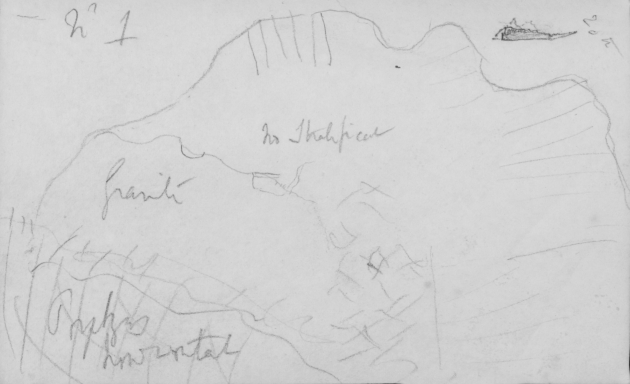
1 See the fair copy of this and the following sketch in the geological diary DAR 36.473A.
[page 76a]
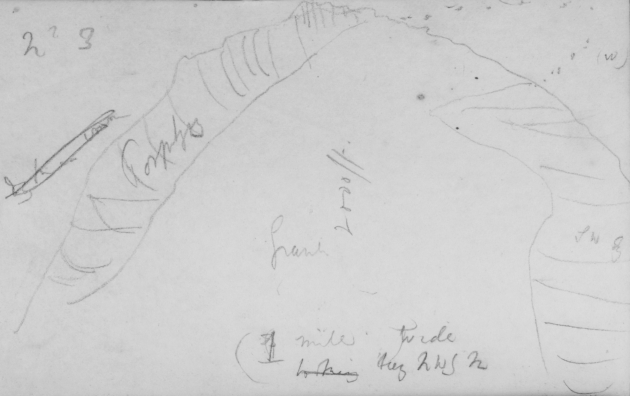
nr 3 dyke imm Porphyry Granite 2000 ft (W) (1 mile wide looking NW by N SW [by]
[page 77a]

1 See a possible fair copy of this sketch in the geological diary DAR 36.474.
[page 78a]
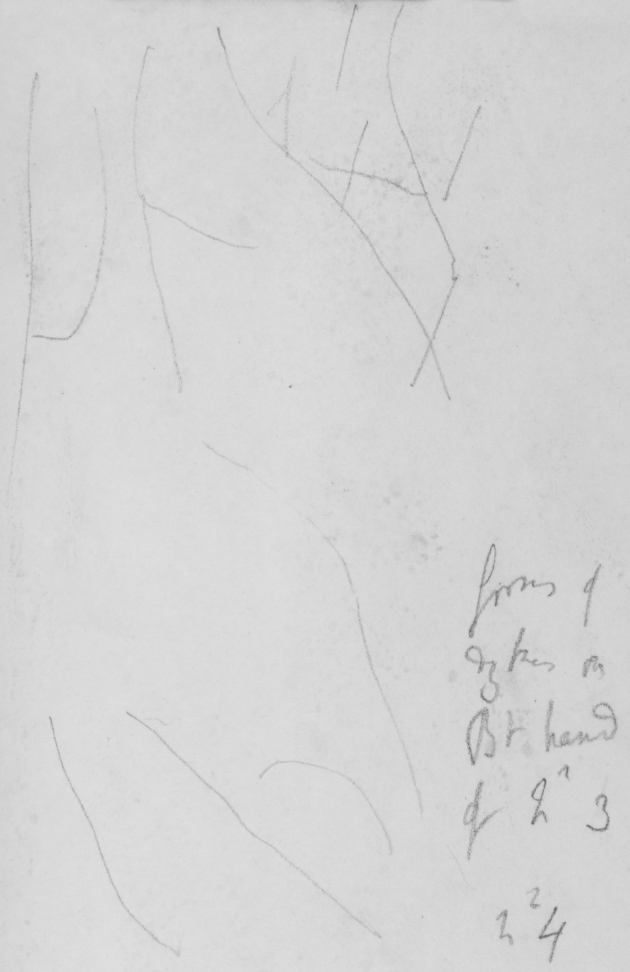
nr 4 [forms] of dykes on Rt hand on nr 3
[page 79a]
(20th—). [March 1833] A little above our sleeping place is the junction of the M R. del Valle del Yeso & the R: of Volcan: with the Syenite some true Granite occurs & there are nests of the green mineral of Quillota & black of Yaquil. — So The granite passes into
(J) variety — judging from fragments is directly covered by black hornblendic rock (G) which in parts is very obscurely brecciated (H) there is some true, hence perhaps origin — The granite affects pap forms hills, & from the
[page 80a]
dip is covered by Brecc: Porph: Beyond this, (just) the valley is partly formed & partly traverses the strata. There dip is about 40° & bends up to vertical as at Cauquenes: I see in the Porph. Brecc — most beautiful & numerous alterations of finer sediments & some included large white beds: we approached a group of lofty very sharp points:
[H] near [it] side of hill traversed by very many dykes. — though diff formation: [illeg] near
[page 81a]
(& for a hours ride shown by fragments), saw appearance as in nr 1; where immense mass of granite joins above in a very undulating (more iron pyrites) line, (& veins) inclined with superior Porph. it is fronted at some little distance by porphyry nearly horizontal — The very peak is inclined at about 70° & curved, the side is only a little inclined: the lower parts appears without stratification. I judge from enormous hills of fragments.— The above section is seen from the west — another main valley
[page 82a]
beyond Cuesta del Indio, shows, the granite (nr 2) ( ) a mountain within another capped by almost vertical Porph: (hence new forms) & curved lateral section. — The line of granite appears to run N by W & S by E. — On opposite side of valley perhaps seen: (nr 3) west side whole mountain dip of about 50° on East side inclined at about 80° to same direction, but tops appear turned over: Traversed by extraordinary net work of green dykes — These are granite dykes traversing the highly inclined strata
[page 83a]
from the mass — (nr 4 large dykes). — magnificent examples of elevation. — explains all rough tops, above snow level. — Fragments of saccharine limestone. Valley very curious higher up:1
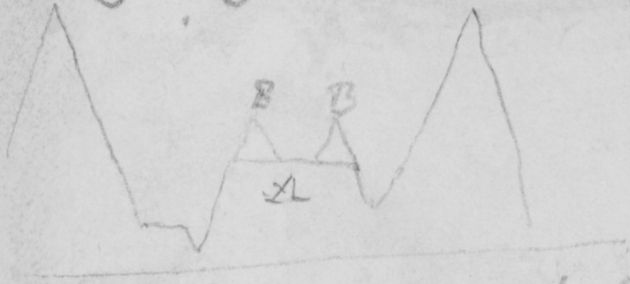 [valleys in the Valle del Yeso] B B A
[valleys in the Valle del Yeso] B B A
A central plain of Alluvium enormous angular fragments separate a valley ravine nearly 1000 ft deep from other 400-500 ft — which run nearly parallel: the mass is generally plain, but for some extent forms valley between two rows of hills of Alluvium as shown
1 See the short description of this moraine in Origin of species, p. 373.
[page 84a]
ascending, again we have a plain, which terminates in a mass of lofty hills perhaps 1500 ft above river, as if pitched by water spout, & hollow round cavities these are same as the lateral hills (BB). the left Rt hand & smaller river arises between these hills, the ravine loosing its depth — The left, larger & Southern stream Valle del Yeso, flows on round their foot — I hardly dare affirm these hills are alluvium — yet fragments chiefly granite & some others, no true rock — To the Eastward of the plain just like bed of lake through
[page 85a]
which the latter river flows

[section showing plain and river] grand plain plain (B) alluvium river [river] The structure of intermediate plain sometimes a valley requires either diluvial action or quiet sea — No proof of quiet sea — either in levelness of hills on head or rounded stones — Properly these hills in
(B) ought to exist in all parts. Alluvium of same height seen on all sides of grand valley. — In bed of lake. river has taken small effect passes out by narrow entrance. — Most striking geology Porphyry. white granite green dykes — Gypsum —
[page 86a]
where dip is mentioned as about 40° — we have following appearance

[sketch section]1 valley A B
in one hill on opposite side of valley strata continue bending up to vertical — at B at very little inclined dipping directly towards latter.
— I believe (B) are the hornblendic rock tilted by granite already mentioned The tilt of A is quite separate although in same hill & dips
Some of the breccia exceedingly
parallel to granite ? — ؟SW direct NW & SE. —
1 See the fair copy of this sketch in the geological diary DAR 36.470.
[page 87a]
pretty patches of green & various coloured fragments: — Where I first noticed granite (nr 1) on the plain fragment as big as house of granite one side large fragments of porphyry united by granite. —
Saw some much of the curious rock & feldspar with the porph: Breccia —
Lost mules: very hot: party from Mendoza — hills very lofty patched with snow. — rode over some natural ice-house purple color — fine peaks from vertical stratification — enormous piles of rubbish —
Mountains few separate, not many lines
[page 88a]
enormous masses — still resplendent clear — dark blue cloudless sky (some little Puna1 ) — very little vegetation, no birds or insects. —
Old Indian house. — after crossing great pile of alluvium Cuesta del [Indio]. striking bed of lake: cattle: Slept with Vaccaros. Valle del Yeso. — Cold — Summit purple rock. —
Condor. 2 large white eggs no nest lay in November or December — a whole year before can fly. are called condors
1 'The short breathing from the rarefied air is called by the Chilenos, Puna', Beagle diary, p. 308.
[page 89a]
with black ruff. white Huitre:
Have seen nothing yet which looks like Lava
[page 90a]

1 See a possible fair copy of this sketch in the geological diary DAR 36.475A.
Pages [90a-91a] of this notebook appeared in the 2003 National Geographic documentary Diagnosing Darwin. The watercolour stains on these pages were assumed to be Darwin's blood stains and samples were taken to search, in vain, for a possible source of Darwin's illness(s). The documentary noted that no evidence for the disease was found, but failed to mention that the sample was watercolour paint, rather than Darwin's blood.
[page 91a]
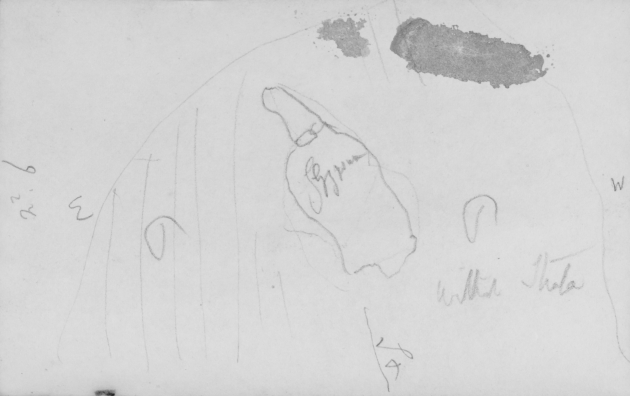
nr 6 E P P W Gypsum S & without Strata
[page 92a]

nr 7 at some distance back G L Sandstone Limestone
[page 93a]
21st [March 1833]—1
L. Breccia (Red Sandstone) section nr. 5
(M) Impure gypsum do
(N) Slaty sonorous Limestone Pass of Puquenos Val del Yeso
(O) Gypsum with lines of black crystals —
(P) Impure gypsum? more abundant not worked with
(Q) Large pap of statuary marble
(R) Concretions in gypsum generally not so dark coloured marble
1 This date appears to be repeated on p. 127a.
[page 94a]
(S) Green . sandstone
(T) Ferruginous sandstone
(W) . do with green Epidote1 (abundant
(V) Porphyry (more crystalline than the rest from protruding pap
(W) Carbonaceous? shale with do [3 or 4 words illeg] Tupunjeta: scenery: condor. cold wind Puna — scenery: colours [form size] profound [despise] Valle del Yeso. Section nr 5. 3 vallies — Puquenos — slaty sandstone Stratification beyond — Red snow — mules. Peaks of snow glaciers — cloudy night mercy of Elements no thunder no danger: picturesque party of travellers from Mendoza
1 Silicate mineral often found in metamorphic rocks.
[page 95a]
beautiful sun rise, showing peaks already bright with sun. — Sulphuretted Hydrogen Potatos not boiled water [pot] did not close The point above the granite is one of the highest in the country. the dip although about 70° is not directly from the granite, but seems influenced by some common cause which has tilted all the neighbouring peaks from 80° - 90° to the West. — The gypsum formation is first seen on South side of valley (of lake) if only seen there great doubt would remain concerning its position: we see a very extensive side of hill great mountain entirely composed of masses which pass into each other suddenly without regular strata. a large patch of one many hundred feet every
[page 96a]
way will contain other varieties or bounded by them. naming the rocks in abundance perhaps an indurated Ferruginous Sandstone (T) which passes into a Quartz rock, & most generally much green crystals (W). We have perhaps in equal quantities an indurated bright green Sandstone (L). & the gypsum formation This consists of fine white saccharine stone, with lines of black crystals (O). & water lines This occurs in enormous masses: it contains large concretions of fine coarsely crystallised marble either white or slate coloured (R). The surface is [rough]
[page 97a]
& marked sometimes with water lines is intimately blended or joined with gypsum: some of the concretions are many feet in each way & of an irregular figure. — There are also large masses of beautiful white masses paps of statuary marble (Q). — Surface curiously traversed by fissures, as if baked, like loaf of bread. — Judging from other places. green Sandstone most regular companion of Gypsum: There is much impure gypsum which is not used for the wine ([Lastos for agua diente]): this occurs in a baked or concretionary
[page 98a]
forms — I saw interstratified in thin & contorted layers with green sandstone. — I only saw one fragment of gypsum crystall. in transparent plates. —
From general slate of all the rocks there can be no doubt action of heat. —
This whole great formation seemed entirely to underline the B. [illeg] as judging from stratification of neighbouring mountains. also such soft beds might be seen traversing in a vertical direction the grand peak above the mines: a little to East of Granite Peaks. —
[page 99a]
yet at the very mine a little ridge or point of vertical Porphyry (V), crystals scarcely perceptible & a black slaty rock (W) to the height of 200-300 ft projects right in the gypsum: which latter rests uncomformably on the top of strata. being separated by broken mass fragments of greensandstone such as occurs contemp with gypsum, I feel no doubt now that it has bodily been forced upwards. Before following sections I was quite at a loss: the gypsum here is not clearly stratified but clearly at right angle. —
[page 100a]
A little higher up in the valley on the north side we have the section (nr 5), where we see an enormous mass of gypsum. I should think at least 1000 ft resting on & covered conformably by the red P. Breccia.
— This probably represents the whole mass of sandstone & gypsum described as a mile or two to the SW. — The gypsum is not very pure, & contains a good deal of Carb of Lime. it is much marked by water lines (M): it rests on a Breccia fine grained
[page 101a]
Very little altered dark red as usual (L). The par. section is not quite a straight one, as where brook enters there is a angle. the lower Breccia bends up, & becomes highly inclined about 70° degrees dips Easterly. conformable to it there is stratum of fine green sandstone, & then again the gypsum. as seen by the water lines is parallel conformable & side by side but angle increasing almost to vertical — These three beds are beautifully seen in contact: The gypsum may be 2-400 ft thick. — Again to the left or west we find a very
[page 102a]
Porph - Brecc dipping at [about] 45, in opp direction [vor] to west — the intermediate space is covered. — on the South side anticlinal line of this valley & directly in S. line at a great elevation (section 6) in the mountain side the gypsum is seen between nearly vertical strata of Porph. Breccia to the west the Porphyry is without stratification & probably corresponds to the opposite dip mentioned in last dip section — I should imagine the gypsum formation is inferior to the grand P. B. [in] the outer
[page 103a]
Cordilleras: — In this neighbourhood I noticed some slaty beds, probably a sandstone with the P. B. — we soon began the long ascent of the talus which forms the pass of Puquenes: there many enormous fragments of a pale brown limestone with immense quantities of Gryphaea: also a piece of an ammonite1 as thick as my arm which formed part of a spire — Higher up we came to a black hard compact Aluminous Limestone which alternated with innumerable layers of a harder slaty sonorous kind (N). This abounded with very imperfect
1 Type of fossil mollusc important for dating Secondary age rocks.
[page 104a]
impressions of Terebratulata & many bivalves1 one only univalve2 except some few ammonites. These Limestones all dipped to the East at ∠ [for] 30° to 45° & some of the points considerably higher up to 70° or 80° — It rested on the red P. Breccia; contained a bed of gypsum, with Limestone Marble & green Sandstone perhaps 2-400 ft thick, which was capped by this Limestone with shells. The very pass is thus formed & neighbouring peaks —
1 Molluscs with two shells (e.g. mussels, oysters).
2 Darwin used the word univalve for snails.
[page 105a]
I shall presently show that probably this Limestone is capped again by Porphyry — Unfortunately I cannot tell the relation of this Limestone with the grand Gypsum formation: Probably the great thickness of the former latter is a local formation: The Limestone must I imagine be at least 3000-5000 ft thick: so difficult to judge: — I imagine from color in some of the mountains of yesterday in the higher parts I saw the Limestone but not to so great thickness. following section will show what I think of
[page 106a]
the superposition. —

[stratigraphical section] 1 B. Porph. — Limestone with gypsum & shells P. Brecc.
2 Gypsum & Sandstone & P. Breccia P. Breccia Granite
The relative position of two groups 1 & 2 is uncertain, but the beds in each known —
If they do not replace each other, such
[page 107a]
must be their superposition:
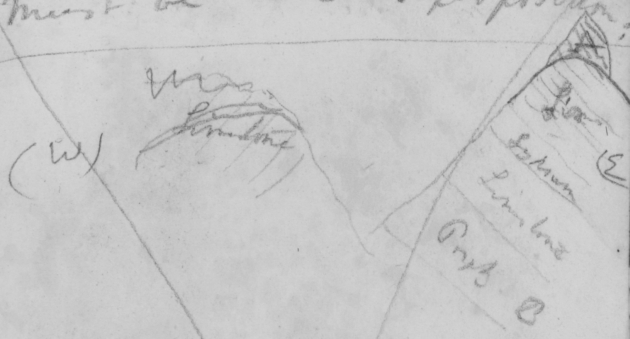
(W) Limestone A (E Lime Gypsum Limestone Porph B
(A) In a W & E section (A) is the pass of Puquenes: beneath which beds will be [seen]. on the west side lower down are anticlinal beds of Limestone will be seen forming a little N & S ravine. — To the north of the pass on west side. [many] most lofty peaks with the wildest forms will be seen with the strata
[page 108a]
dipping from 70° — 80°. These strata generally bend up in a small curve from the ridge where inclination is rather less. — These peaks & ridge formed either of Limestone or P. B. form, as (on W. side) 3 or four anticlinal ridges lines, N & S ravines occurring both in synclinal & anticlinal parts. --

I have omitted to state, all these lines are about NNE & SSE
[page 109a]
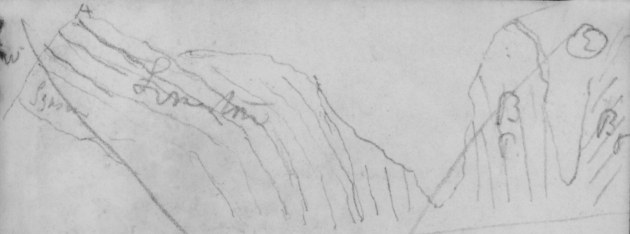
W Gypsum Limestone BP BP E
Having crossed the pass — we rode over Limestone dipping, as before regularly Easterly: [where] to the north of the main valley (of degradation in which road lies E & W) the Limestone may be seen gradually bending till it becomes nearly Vertical: across a little ravine we see very red Porph. Brecc with same dip, which wh is [yet] a little Easterly — again there is a broader valley & the Porphyry dips at about 45° to west —
[page 110a]
(Section nr 7) is on the opposite side of the valley of degradation [a] to the South. The gently inclined Limestone meets by a fault that of 70° degrees. the inclination of which increases till it is nearly vertical when it lies along side some of the bright red Porphyry: These sections prove, I think that the Limestone is properly covered by the
B. Porph. — I may mention that the Limestone on this slope also contained fossil remains —
[page 111a]

(W) 1 (2) 2 2 3 4 5 P Limestone Gypsum Limestone (E Section on North side of valley proceeding Eastwards. — Beyond the nearly vertical: we see mountain of very red P. Breccia: beneath which there appeared to be (2) Limestone, which contained a bed of same thickness as last section of gypsum (4). beyond this we have again the Limestone (∠ about 45° exactly same nature: all this is identical, with the section of the last pass & is clearly owing another parallel
[page 112a]
line of elevation (Z) being Zynclinal line. —
Limestone (5) had [gr] ∠ perhaps 60°

W Limestone Congom C (E Again to the East of last hill of Limestone: we have for the space of some miles a succession of hills of Conglomerate bed from 1500 to 2000 ft. thick, color reddish sufficiently hard for small pebbles to break before extraction, large one will come out
[page 113a]
it is very hard — The dip was almost everywhere about 45°, as shown by line of pebbles: Excepting that close to the base of the Limestone the dip was a little less 20° or 30°. from every point of view it appeared most unquestionably to dip directly under the Limestone: Seeing this, & colour & Brecc. Conglom. structure, I came to first to conclusion that this was the case: when I examined it I found there was not Porph: structure in matrix, & on examining the pebbles few were crystalline but the black Limestone, with its shells & the peculiar
[page 114a]
Sandstone which accompany the Gypsum. — This made the case clear. — The Conglomerate appears to have undergone action of heat: rises into lofty mountains, [fronting] the Escarpements, (at less however elevation) of the Limestone: It will be seen perhaps owing to upheaval of granite of Portillo chain. — Marine deposit. —
(X) This new conglomerate
(3) Hill of Porphyry in do
(2) Slaty micaceous Sandstone
[page 115a]
(1) do converted into Quartz rock
(2) Protogene1 W of Portillo
(3) & 2) Reddish [Eurite] in granite
(4) Serpentine (?)
(5) Gneiss on East Slope This new conglomerates fill up the space between Limestone at base of Puquenes range & the Portillo range. [Only] fringe round one hill of Porphyry (nearer to the latter range) which Porphyry (4) is one of the rare instance [where] for what I can see to the contrary may
1 The 'earliest' rocks. In Darwin's day it tended to mean gneiss and other crystalline rocks. Closely related to Primitive.
[page 116a]
may have flowed. —
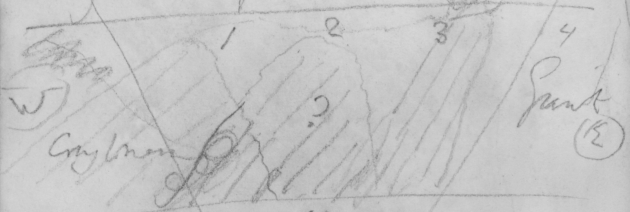
1 conglomerate 2 ? 3 4 Granite E
(1) The conglomerate rests conformably on some soft (2) & variously coloured beds the nature & age of which I am ignorant of they appear soft & like wacke in the manner in which they crumble: — These rest on inclined beds of a very evenly & much laminated (z) micaceous hard Sandstone; this, have been traversed by some soft
[page 117a]
porphyritic dykes: & containing some hard. black clay-slate: This rests on the grand granite range — Where near the granite it is converted into stratified granular quartz rock (1). — It is traversed (near here) by grand system of granite dykes, well seen by red colour of Granite. — Is is this Sandstone same age as Conglomerate, with which it is conformable, or much older. — The granite extends a long distance to the
[page 118a]
west of Portillo. it is almost all Protogene (2). large red crystals of feldspar & do of quartz in lines (some Epidote), little Chlorite. Hornblende or Mica — Porphyritic with large crystals of Feldspar There is some true Granite. Forms pointed conical hills in enormous groups — At the the Portillo it is chiefly a grey syenite or granite fine grained. is traversed by great dyke shaped masses of hard flesh-coloured Eurite,1 hard, strike [illeg] (3) & som also serpentine? (4) Also a soft
1 In Darwin's time this meant a variety of syenite which showed evidence of having flowed freely.
[page 119a]
decomposed. substance like wacke. — Such forms the very Portillo. Also on one side saw near this spot a stratified mass reposing on granite. of some soft substances of same color & structure as noticed on other side as overlying: the slaty Sandstone: But the granite as I have said extends right across the ridge. On the eastern slope judging from fragments there is both ferruginous quartz & gneiss — at the Manantiales where first vegetation begins, there was much fine white granite containing oftentimes prisms
[page 120a]
of Hornblende. This chiefly was on the N. side on the South Protogene: which lower down the valley was universal of a fine red color, forms peaked cones: peaks owing vertical planes of fissures: in some places this protogene passed very much into the nature of the compact. flesh-colored dyke of the Portillo. Having often seen in many places the true white granite traversed by red dykes near the Portillo. & the general distinctness of the hills of the two sorts. I very much suspect the Protogene is of posterior injected origin: descending
[page 121a]
by the Mal Paso The protogene is capped in very many places by grand horizontal mass of a gneiss, with numerous [wavy] lines of quartz exactly as in Chiloe. — The Protogene projects in little points through it: has pieces sticking on the sides; is entirely naked or covered in horizontal manner: In an enormous mass which had fallen down, I examined the junction; the cleavage of gneiss is at right angles to it. — the Protogene sends off small veins into it & includes fragments. — Lower down the valley the gneiss seems to pass into a grey
[page 122a]
harsh stratified laminated mass of granular slate (6). — The (Los Arenales) ravine in which all this is seen runs almost directly from little below. Portillo to Pampas in East line. — whereas the road in the other side is zigzag. crossing apparent from one [illeg] valley to
Sandstone, which dips conformably with the Conglomerate of the same age or much anterior: it contained no fossil remains I could see: ? — The question is an interesting one. — I feel no doubt that the whole Portillo
Is the slaty ؟other. by the water courses. — ? I can well im
[page 123a]
range has been elevated subsequently to the Limestone one having been partially elevated into dry land. —
In the last section, there was a fact showing the complication of the stratification:

) Granite Limestone ? Conglomerate Conglom
A hill (A) a little to the South apparently composed of B. Porph. dipped at about ∠ 20° right towards the granite range. —
In the valley between Portillo & Puquenes ridge there was some very cellular Tufa. — Probably connected with neighbour Tupungata —
no Lava —
[page 124a]
The granite extends at least mile to the west of Portillo:
[Ribbon] jasper with first Gypsum formation in fragments: —
The last section shows that probably there has been more than one line of elevation in space between two ranges
At foot of granite [of] Protogene, where covered by slaty qua sandstone, there was a small arch of do reminded me of main range in Falklands. —

W sandstone granite Early in journey, noticed in many places in P. Breccia. the [em] spherical - -columnar structure
[page 125a]
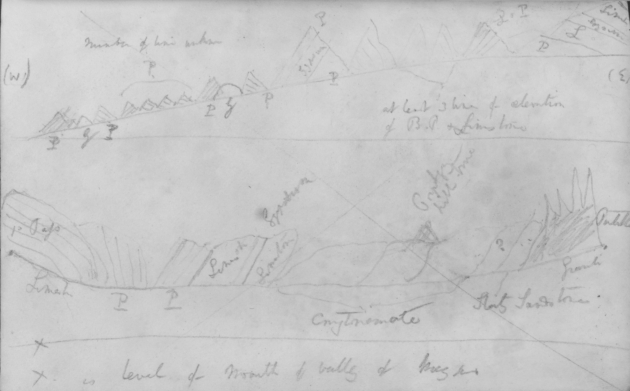
[section of from the Maypu to the Portillo Range]
(W) number of lines anterior P G P P G P gypsum 10 Lime at least 3 lines of elevation of B.P & Limestone (E) 1s Pass Limest P P Limest Gypsum = R2 Limestone Conglomerate Porphyry [Hill] [true] ? Slaty Sandstone Granite Portillo X is level of mouth of valley of Maypu
[page 126a]
Red Snow1 — seen on both of the highest ridges. — (little spores, rather more than twice their diameter apart above limit of perpetual snow. — appeared like bits of dirt brown dirt scattered over snow — partly optical deception seen through the globule of ice: appeared of all sizes. to at at 1/8th of inch — When picked up appear to disappear: Examined in lens are groups of 20-40 little circular balls — through both lens. appear like eggs of small molluscous animal: — Crushed stain fingers, & paper noticed by hoofs of mules & where thawed: thought it dust of Brecc Porph: although remembering Miers:2 color where mules had trod, beautiful rose with slight tint of brick
1 The red snow is discussed in an entry dated 20 March 1835 in Zoology notes, pp. 286-7 and Beagle diary, p. 309, Journal of researches, pp. 394-5, and Beagle plants, pp. 207-9. Keynes identifies the 'spores' as the alga Chlamydomonas nivalis, Zoology notes, p. 288.
2 Miers 1826, vol.1, pp. 322-3.
[page 127a]
red: examine paper At great height — saw condor — common sparrow & grey bird very high of flock of plover — also black Furnarius — P. Julian Finch. — many plants & bushes the same
# 21st [March 1835] We left our friends the workers of gypsum: & continued up the flat valley. — curious deception seeing a flat valley with inclination towards one, appeared inclined opposite direction. — Flock of Condors [gogged]: ascent of first range of Puquenes. zigzag very steep: few yards. mules breath: admirable mules: wild party long string crys. appear so diminutive no vegetation to compare with: passed over much perpetual
[page 128a]
view looking westerly up valley. from below Mal Paso. showing Protogene & gneiss.—
shaded parts latter.—
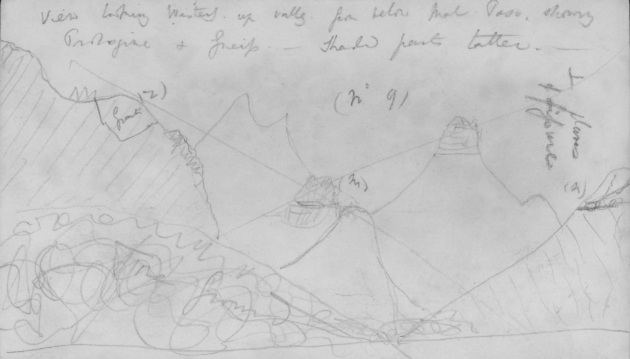
1 See the fair copy of this sketch in the geological diary DAR 36.490v.
[page 129a]
snow — red snow — curious peaks: dead horse beyond Portillo: upside down. — Puna: strange ideas about: all the water here has Puna. — tightness of head & chest: like running on frosty morning after warm — room: — running fifty yards deep & difficult no other sensation: imagination much to do with it — fossil shells forget — people die of it? graves — Resplendently clear — piles of Talus, bright coloured rock. — magnificent wild forms. — (view from the 1st ridge) something inexpressibly grand: would not speak: despise taste of those: like Thunder-storm: splendid contrast of colours — snow. —
[page 130a]
profound valleys — no insects few birds — Condor — little pretty plants — many torrents: excessively cold wind — Slept at night at the foot of the first pass: where little vegetation appears, headache — bad fire: pot all night boiling Peons conversing, "The cursed pot does not choose to boil Potatoes" amusing conclusion — Cloudy night: after excessively cold evening: mercy of elements: no thunder no danger on awakening the Arriero — Saw Tupungata immense beds of perpetual
[page 131a]
snow. — a whole district goes by that name. — Small glaciers I think: Arriero has seen smoke. — Never shall forget the grandeur of the view from first pass. —
22d [March 1835] Hilly intermediate country just within limits of vegetation: in two months of year send Cattle: dare not do so now —
nearly all the Guanaco have gone — [illeg]
Cloud disappeared showed us the peaks already bright in the sun. appeared through gaps in mist of stupendous height: smell of Sulp.-
Hydrogen said only to be perceived in the morning.
[page 132a]
Began ascent of Portillo: wild red granite peaks: fine view of the Crater of Tupungata & the Escarpements of last ridge: perpetual snow
— frozen spiculae fell thick all mist. — Portillo narrow — descended to vegetation: good protection beneath big stones — clouds disappeared severe frost
— moon & stars — excessively bright — several parties anxious enquiries about snow — mis
23d [March 1835] Descended ravine, much steeper & shorter than ascent: grand plain like sea of
[page 133a]
white clouds. beneath brilliant where we were: hid the equally level Pampas. — Entered the [band] clouds the region of bushes & stopped at one oclock. — In mist whole day. — (Los Arenales)
24th [March 1835] — Vegetation spring bushes. many flowers like Patagonia: Blue & Orange finch long-tailed tit: tufted do. red-tail Furnarius. Guanaco dung in heap: just the same in appearance (Ulloa):1 very many mice: Biscatcha on a peak: very different aspect: more bushy tail. tinge of red in breast: Viviparous (Autumn) Lizard: centre of back. scales. black edged narrowly with dirty yellow this band broadest in centre: on each side of this ash-colored space:— sides scales blackish brown: rather more broadly edged with yellow — Belly pale ash color; legs & head
1 Ulloa 1806, 1: 440-1.
[page 134a]
do. [furnished] with few black spots: killed by blow of hammer: young are protruded: soon died: amongst fragments of mica slate,
high barren mountain first limit of bushes. —
Mr Gay Valdivia elevation 6-7000 ft
(6). Gneiss
(7) Black Clay Slate with impressions of crystals of Iron Pyrites (8). Grand system of Porph. Eurit. dykes in do.
(9) one dyke in do.
(10) dyke between protogene & slates
(11) Lowest bed of Greystone1 Lava with Olivine
(12). do higher up
(13). a variety of Basaltic Lava
(14). Intermediate bed of Scoria In water course nothing but gneiss & granite & Protogine latter most abundant Pass of Puquenes, divortium aquarum: & Mendoza thick
1 A general term for lavas intermediate between basalts and trachytes.
[page 135a]
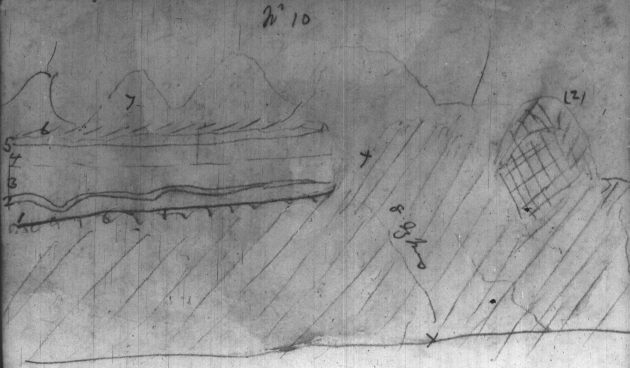
nr 10 1 2 3 4 5 6 7 8 dykes (z)
[page 136a]
Snake,1 sandy plain. Chaquaio — color primrose yellow with broad jet-black bands, which contain bright scarlet red square marks: belly black, except beyond tail where rings of black & scarlet are continued all round — Scarlet brightest near head — young one —
I have already said that the gneiss regularly reposes on the Protogine & that its dip of cleavage is Easterly: nr. 9 represents a view where shaded parts are gneiss. — cannot fancy a more curious one: contrast of colors
highest peaks just covered, some base & lower down from other point of view exact correspondence
1 Specimen in spirits 1233 in Zoology notes, p. 359.
[page 137a]
on opposite sides of profound valley in height of horizontal line of Protogine, no limit of excavation of valleys. — nr. 10 is continuation of [Panorama] to the South: (z) in each case being same lump of granite on a slope of gneiss perhaps. 1200 ft is a cliff of Lava from 3-400 ft thick: this Lava declines a little to the East. but not so great angle on the gneiss. — The surface is not level, is seen resting on, backed to the West & to the South by gneiss in this latter quarter, great bare hills of Protogine project up through the gneiss, close on to the gran Lava. (7) are these hills, which cannot be seen, from this point of view: I traced the gneiss almost up to the Lava but not junction: the gneiss Spec (6) contained in one place black clay slate (7). —
[page 138a]
The formation is remarkable by 8 great dykes of porphyritic Eurite (Spec 8). the lowest is greenish with fine large crystals of Feldspar, the others are all exactly similar, rock of pale color, where the base is now yellowish, apparently originally of a pale greenish with small crystals: — These dykes are parallel to the layers of gneiss — I only know they are dykes by examining the junctions in two places, which is waving & violent, each rock perfect character in contact: some of the upper ones are quite break their parallelism: most of the dykes are 20-30 ft thick & in the middle of hill are nearly as abundant as the gneiss. — I have said, how completely the gneiss forms a scale over
[page 139a]
the Protogine (where I examined junction behind Lava, Protogine contained some white variety): who will say that these dyke do not come from the Protogine? There was one black irregular dyke (9): & another ferruginous sort, traversed the junction of Protogine & gneiss: It is manifest even from the Pampas: that the whole of the Protogine has once been covered up & much clearly remains to the South — from color so much bare Protogine is an unusual phenomenon.
Returning to section (10) 2 is pap of granite as in (7) rising in gneiss
(1) in lowest bed of Greystone Lava with olivine: laminated these laminae often curved & nearly vertical (Spec 11) (2). bed 25 ft thick of broken pieces of red compact scoriae, cemented together apparent by an aqueous cement
[page 140a]
whitish (Spec of scoriae 14) are pebble of basalt: bed very uneven: undulating (3 & 4) two beds (as they appear) of greystone (Spec 12) (5). Covering of cemented red scoriae as before — There is some basalt, for I saw much large fragments (Spec 13) — (6) Covering of alluvium, thick some rounded pebbles, cemented in places together by mortar: — Descending valley to the Guardina, we there meet form: of Tufa: light stone compact, scales of mica numerous fragments of Pumice & some few bits of hard rock (used as dripping stone in Mendoza), is continued for some extent in little water worn hills & on sides of valleys
[page 141a]
The Lava has clearly been deposited before the present valley has been excavated: it must have come from north side, for we have [traced] old rocks on W & S side & it declines to East side. — Could not see any crater-formed hill. — After the valley had partially been excavated, the Tufa must have deposited, which has subsequently been cut through the underlying gneiss — The tufa forms a line of cliffs beneath the Lava — At the base of the Protogine hills mountains: the foot of Cordilleras is composed only, a few little water worn mole hills — Beneath the Tufa saw a pap of white granite coated by gneiss. — The Lava continues to descend. (columnar in one spot) is at last stopped (but must have
[page 142a]
been before present transverse opening) by a line of low hills which dip NW by W & SE by E. — The Lava regularly abuts up against these hills being perhaps 200 ft thick. — The extreme ranges of low hills, mole hills as I have said are oblique to main ranges. — there are several of them, but none [had] much more than 500-600 ft high above [br] sloping plain: The first I examined is entirely composed of bright purple & red Porphyry (with grains of quartz) only in one place. I saw Breccia structure; they run NW by W & SE by E; are traversed by river. — The next was a Porphyry color like protogine, almost composed of brick-coloured feldspar —
[page 143a]
perhaps ejected. I omitted the first had a very obscure dip of about 60 70° to SW. — Beyond this there was one other range, which I believe the to be Porph. Breccia: After what we have seen cannot doubt that there are paps of granite not far beneath: perhaps probably they appear as in some places: The recent upheaval of Protogine explains great deficiency of Porph. Brecc. at this part of Eastern slope: proved by Patagonian pebble bed not general the case. — white-tailed Callandra: white-tailed humming bird — little parrot: These low hills are separated by broad flat valleys: where Porphyry: pebbles are white washed exactly as in Patagonia these valleys perfectly unite
[page 144a]
with the slope which for a distance of nearly 10 miles forms a considerable angle with the Pampas — vegetation exactly like R. Negro. — Where Porphyry low ranges were nothing but pebbles from them. — Further in the plain [large] rounded blocks of Granite: NB. Beside (ejected?) red Porphyry, there were other hills of whitish do — did not start till midday, ascended volcanic beds — view of Pampas: dark blue, from rising Eastern sun: striking line of glittering water lost in immense distance: very level to the South. considerable undulations to the North: passed Guardia. heard of much rain! day before, the clouds which formed beneath our
[page 145a]
feet — true Pampas Indian: kept to hunt: always one: some few years. came across tracks of one who had passed on one side. hunted him whole day; over dry stony mountain & found him concealed. — on Horseback? Entered broad flat valleys: view of Pampas again — I think more striking, certainly very like the sea — termination of view: passed Estancia of Chaquaio. — entered Sloping plain, like R. Negro: appeared no distance, but very long. bivouaced for night. — Little oblique water-worn ranges, send little spurs into the sloping platform on plain. S. [illeg] Patagonia. no water
25th. [March 1835] — Sunrise — intersected by dead straight line — in a paralellogram figure on rising — Spider:1 habitation in centre web (refine. segments of regular Vertical net work being attached? to them from which strong web lines go in all directions [very] numerous: Los Arenales
1 Specimen in spirits 1234 in Zoology notes, p. 359.
[page 146a]
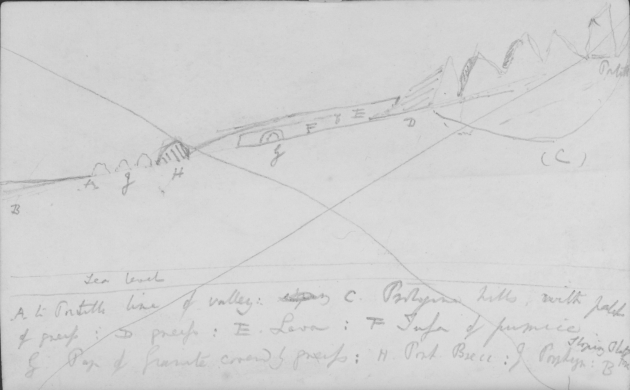
B A q q E D C Portillo Sea Level
A. to Portillo line of valley: sloping C. Protogine hills, with patch of gneiss: D gneiss: E Lava: F Tufa of pumice.
G. Pap of Granite covered by gneiss: H Porph Brecc: J Porphyry: B sloping platform
[See Barlow plate 11 (lower) p. 168]
[page 147a]
struck right east. till we left the sloping platform: & came to level marshy ground which again was succeeded by low plain: cooled with much saltpetre & plants same as B. Blanca: before this passed two or three Estancias: To the East I see low escarpments. is this low ground, owing to the want of upheaval or removing action of water: country formed of horizontal layers of sandy earth apparently overlying gravel of Porphyry. — In a cliff I noticed that a thick efflorescence extended as far as soil
does Humboldt say about the effect of draining? Day very hot — stupid ride: stopped at what ؟would be damp with floods. — no vegetation on this talus:
[page 148a]
Estancado one Rancho hardly saw a person: Gallinazo1 bend of river & Black & White Muscicapa: Can see Pampas from Portillo.
26th. [March 1835] — Dew last night in Traversia in Cordilleras scarcely any: this days ride is called 17 leagues through a Traversia — with only one house where there is water — quite level very hot — less so on the mule. — On our right hand we had for many miles a regular low escarpment, perhaps 80 ft high — perhaps 15 miles from Cordilleras: with valleys entering on the lower plain: upper plain composed entirely
(15) 2646
1 The black vulture, also known as the Cuervo; listed as Cathartes atratus in Birds, p. 7.
[page 149a]
of Porphyry pebbles, cemented by light friable calcareous matter. not to be distinguished from R Negro — pebbles many as big as mans head — above this other escarpement — clearly an island! — Lower plain — some Tosca — a little Tosca rock — lines of small Porphy pebbles — fine white sand & do [dun] aluminous powder: — I fancy much Protogine all along Cordilleras. — 3 Tupungalos — extensive secondary1 ranges near Luxan — Tufted Partridge ostrich Biscatcha Peechey —
Horse have not passed. — 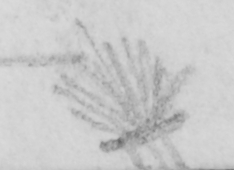
1 Rocks of an age intermediate between Transition and Tertiary. More or less equivalent to the current Mesozoic but extending down to include rocks now called Upper Palaeozoic (e.g. Carboniferous).
[page 150a]
long wearisome ride, scarcely met a person. — Near Luxan: noticed as I thought heavy smoke — turned out to be locust — cloud quite impervious ragged — reddish brown: all flying north: many scattered outlyers resting on ground — in these advanced guards sky like Mezzotint engraving — main body about 20ft above ground perhaps 10 miles an hour — with light breeze from South perhaps 2000 3000 ft high. — Noise that of strong breeze through rigging of ship
[page 151a]
Where ma a cloud hadalightedfar more than leaves in the trees — fields tinged with their color. — people sticks & shouts: had been coming for many days past — but curiously had never crossed the River till this day — Poplars stripped of their leaves — from Traversia: affect not explicable; avoid being struck: after the clouds had once alighted they appeared then to fly E & W or any way. — distant red cloud so like heavy smoke that we disputed for some time
[page 152a]
common pest: the greater number appeared resting than eating. = crossed river entered Luxan (NB. the clouds of Locusts gradually thickened & thinned) refreshing rows of Poplars & Willows & artificial brooks — very small village. — At night good to experience every thing on[c]e. — Chinches1 the giant bugs of the Pampas: horribly disgusting, to feel numerous creatures nearly an inch long & black crawling soft in all parts of your person — gorged with your blood. —
27th [March 1835] — Luxan — to Mendoza 5 leagues quite level — like Chili —
1 Local name for bed bugs (Triatoma infestans) or 'Vinchuca' bug, often spelled 'Benchuca' by Darwin. See Beagle diary, p. 315 and Darwin's insects, p. 89.
[page 153a]
beautifully cultivated square mud walls — house with roofs of do — immense orchards of figs peaches vines olives — celebrated with fruit. —
Inhabitants sad drunken raggermuffins — Pampas continues ⅔
Indians & reckless manners, but not the elegance of further East. —
All horsemen: Village nearly all the way —
At Luxan immense water melon for ½ penny a piece: half a wheel Barrow full of peaches for 2 ½ —
(28th) [March 1835] Mendoza — nothing can be added to Heads1 description; people themselves it is a good place to live in, but not to prosper
1 Head 1826.
[page 154a]
Alameda — pretty, very kept. Cordilleras tame: scenery no comparison with St Jago: — very quiet. Big bones. R. — Quarto & Los Gigantes Governor polite old man — everyone polite in these countries the commonest peons looking at a old black woman with large goitre touched his hat respectfully evidently as an apology for looking at her: —
(29th). [March 1835] no Blue Sparrow = Aparea = Queriquincha1 very fine grapes: extreme heat & dust of plain. — Goitres
1 Nine-banded armadillo. See specimen in spirits 375 ('the Taturia Pichiz' [mistranscription of 'Tatusia pichiy') in Zoology notes, pp. 179, 332.
[page 155a]
Plain from Mendoza to V. Vicencio. Greywacke pebbles: hillocks of alluvium (white washed) horizontal stratified: distant escarpements obscure: near the entrance valley small outlying ridges appear rather wedge shaped than ridges. — On entering greywacke, some little rather coarse, greenish [dusky] color, generally fine almost passing into clay-slate but little laminated excepting in parts — strata (or cleavage?) nearly vertical: perhaps most general about NE & SW strike: some contorted & some great faults: all first range composed of this; alternation of more & less laminated rock. —
[page 156a]
Rode all day, Traversia, no water or horses (NB. Greywacke must contain a grey crystalline limestone, for there is a quarry in a hill on road: this greywacke from fragments, forms whole face of Cordilleras in this part) — level. particularly desert. Guanacos — Entered valley slept at V. Vicencio — Head & Miers.1 — brooks larger as we went up as S. Ventana explains dryness of sloping talus. — Mendoza all town & [Cheucsas]: Locust never go north of Mendoza.2
1 Head 1826; Miers 1826.
2 '3152. Locust v. private ground P. Mendoza.' Darwin's insects, p. 90.
[page 157a]
30th — Villa Vicencio [March 1835]
(16) — Greywacke — moderately coarse
17 — Clay - slate fine laminated [soft]
18 — Breccia conglomerate above purple slate
19 — Pebble from do of porphyry. —
20 Sandstone with yellow water lines
21 — Purplish do — |
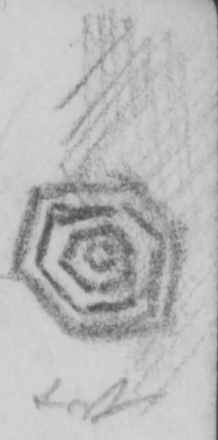 |
22 White coarse [substance] with foreign particles
23 — Do finer grained harder tinge of green Baths mile from house. in Greywacke & Slate — appears to be anticlinal band at spot: four walls diff. Temp. most hot only tepid (Elmis Colymbetes Tadpole) slight taste of Sulph of Soda? & other brooks higher up — purgative: Greywacke (16) alternates with fine blue laminated clay slate (17), which certainly is more abundant more
[page 158a]
in the interior: dip of nearly all the slate is high 45° to 80° — I really cannot tell whether cleavage or strata. — the main band runs N & S
— a great formation, the lower ban ridge chiefly runs NE & SW: the dip at in these high hills dips all westerly or towards the hills; ascending (Blue clay slate in very regular strata traversed at rt ∠'s by many quartz veins) found the Clay Slate covered by purple variety in all parts, & this again by a coarse softish white Breccia Conglomerate
(18) particles of quartz, the pebbles chiefly
[page 159a]
Porphyry (19); of such varieties as are found on other side; we then have (neither of these beds are very thick) & appear conformable in one section): an immense mass of a sandstone cemented (20) with white particles & curvilinear ferruginous water lines: also a purple sandstone which (21) passes into a fine varieties which cannot be distinguished from those beneath the conglomerate: also much softish white aluminous rock with foreign particles (22) & a compact greenish tinge fine grained of same nature (23) besides those there are varieties of greenish & Blueish rocks
[page 160a]
which are closely connected with nature of clay-slate: I saw above in one locality the conglom a little common blue slate: All these varieties seem blended in [one] hills without much order, in another section they alternated in very numerous strata: these formations extended far to the west, dipping to west with tame outline: I must remark that certainly the dip of these curious white soft beds is less than the laminated blue slate: in one case they appeared quite conformable, in another they appeared not
[page 161a]
so. I almost traced the very junction: the blue thinly laminated blue slate; became more rotten, cleavage slightly curvilinear; & crossed by other system at right angles so that it became a mass of splinters; & vertical cleavage hardly perceptible changed color becoming greenish & brownish, this was close to the Purple, [the] the stratum of which was inclined at less angle now in other case, the purple & blue were conformable — I strongly suspect that the mechanical beds above are influenced by that law noticed in the Falkland Isd. — However this may be I feel sure the soft beds are superior parts of same formation: the purple rock being the connecting
[page 162a]
link — appearing above & below, & indeed other varieties of the Slates: From the Further to the West much reddish rock is seen to succeed. — The conglomerate is in some places so loose that pebbles of hard Porphyry can be extracted of all sizes degrees of rotundity. there are no slate pebbles. — The fact is important as connection with the rocks & conglomerate overlying clay-slate (conformably) West of Portillo. It tends to prove that clay-slates is here are more recent than the Limestone & Porphyry: I strongly suspect the white, purple & brown
[page 163a]
soft strata between Sandstone & Conglom. — W of Portillo are of this nature: (Clay slate have no Organ. remains, splintery fracture) (In all the valleys much Tufa). Villa Vicencio notorious from Mr Miers Scenery very tame) — (There is no such great difference of the Greywacke [of] the Clay Slate & the Pale Sandstone with the Aluminous beds. —
 [section 'lofty hill']
[section 'lofty hill']
hill very lofty upper part drawn too large A B at least 2000 ft above
V. Vicentio
(A) The conformable parts — (B) where they appear [not] be so. Slates altering as described dotted line [division] [when] between two classes: — This distinctness of ∠ of dip is also seen in general scenery of country
[page 164a]
April 1st [1835]1
 [section with heights]2
[section with heights]2
Hornillos Wes 29:30 24&c 28 24& 27 24.25 8 7 6 5 4 3 2 1 50ft 80ft
(hill 400 ft 4 or 5)
24.25 — Aluminous Sandstone 26 (do) in close contact with 27
(27) Feldspathic white greenstone Lava
(28) Pitchstone3
(29:30) Augitic Lava, mixed with some [Toadstone];4 parts slightly concentric structure & little Pitchstone, imperfect. Bed (1) is superior to the Various Porphyries is in places fine grained & compact is covered conformably by fine crystalline
1 The actual date was 31 March 1835.
2 See the fair copy of this sketch in the geological diary DAR 36.508 and Herbert 2007, p. 317.
3 Glassy acid lava.
4 A term for various igneous rocks. Derived from Tödstein (rock with no ore).
[page 165a]
sonorous rock, angular structure of a white Feldspathic Lava (27) the inferior junction is not well defined the sediment appearing to contain balls of the Lava & being harder & altered in contact (26): This Lava is again capped by fine sediment which contains a bed of Pitchstone generally with brecciated structure (28) scarcely 2ft thick. Above this the sediment (ferruginous water lines in all places) sediment containing some layers of large rounded crystaline pebbles. one or two larger than my fist & well rounded. they are of the same white Porphyry as in Conglomerate (18) of yesterday: Again we have varieties of (27) Lava. — Sediment & then the Augitic
[page 166a]
Lava (Bed 8) (Spec 29: 30) This section is [right] West of the houses.
— I omitted to state the junction of Augitic & its inferior sediment is defined the rocks 2 miles apart possessing their true character The Mines
(31) Hardened white aluminous rock at base of Granite: metallic fumes.
(32) Granite
(33) Fine white Granitic dyke percolating the Sandstones which are converted into Quartz, as may be seen, above Granite
(34) Veta in ; Granite
(35) pieces of the best auriferous1 [Gia] in do The Boque Mine
(36: 37) the curious white rocks in which veins occur
(38) one of the best ores, said to be Phosph of Lime
1 Containing gold.
[page 167a]
(39: 40) The regular gold ores (41). (like clay) a veins just opened; contains some Pyrites deep down thought to be good sign. At the houses (Blue [Baize]): grand curious Porphyry beds of Lava: (42) a loose fragment but I do not doubt from same locality (43) — The very limit where crystalline rock joins to a greenish rock like following: (44: 45) occur with the white aluminous sandstones: organic impressions comes from bed (1) in last section. —
(46) Metallic vein said to contain silver in above bed: (47: 48) parts of do bed stained by metallic fumes (49: 50) Sandstone &c beneath the curious Porphyry. —
(51) do very abundant —
(52) white rock blasted by fumes, near a vein
[page 168a]
(53) Lowest Lava bed
(54) White dyke in the Clay Slate Passing from V. Vicencia to the Hornillos, we pass Clay-Slate & Grewwacke: where we last see fine laminated Clay Slate: the cleavage is variable, chiefly about 80° to the S & SW ∴ running nearly E & W: on the west extremity of the plates: a red greywacke, so compact, as almost to resemble Porphyry & dips to the West & certainly appears unconformable (I omitted to state the Clay Slate is traversed by nearly vertical of dyke of soft white rock (54): the undulating edge shows it is not bed I believe if dyke it may be fissure filled up) although such it appears the cleavage of slate becomes tortuous & less inclined & seems to contain some of the very red rock: a short distance further on we
[page 169a]
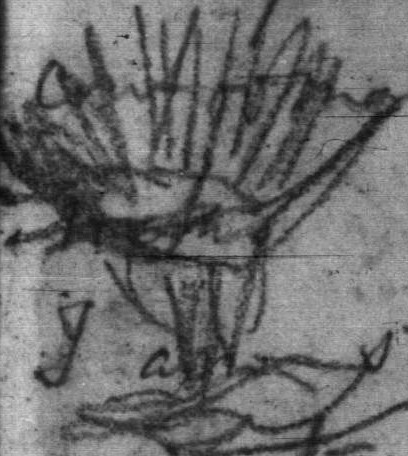 |
see purple & blue clay slate apparently conformable right beneath the white rocks dipping about 30° westerly. — I am still more strongly inclined to suspect that Falkland case here occurs: following the valley we have the white rocks (such as top of yesterdays mountain, & this is just in the N & S line seen running up the country but rather lower; there is not here so much of the purple rocks: |
see purple & blue clay slate apparently conformable right beneath the white rocks dipping about 30° westerly. — I am still more strongly inclined to suspect that Falkland case here occurs: following the valley we have the white rocks (such as top of yesterdays mountain, & this is just in the N & S line seen running up the country but rather lower; there is not here so much of the purple rocks:
these beds are many hundred feet thick; we then come to a bed of crystalline rock, with a slight curved columnar structure (53): where it rests on the sediment the latter is harder & has assumed a slightly spherical structure & of a purplish color — there are many large pebbles of hard, sonorous purple conch: fract Porphyry with few crystals but grains of quartz one is inclined to attribute the purple color to degradation of Porphyry rocks.
[page 170a]
The crystalline bed is perhaps about 100-200 ft thick; it is covered conformably by a repetition of the white sediments; all dipping about 25°-30° westerly. These sediments consist of sandstone with ferruginous lines, more or less coarse & more or less cemented by aluminous white matter. Spec (49. 50 51). These beds perhaps 400ft thick: Close beneath the superincumbent crystalline rocks are very curious. I do not think 100 specimens would show all varieties; spec with [base] will show some; the bed is perhaps 250 ft thick (all these measurements very inaccurate) is abundantly amygdaloid: & every where highly crystalline, varieties pass into each other without law): the inferior point of junction is distinct
[page 171a]
on a large side, the very point the two substances seem rather blended: (43) in the lowest bit of crystalline rock — This most extraordinary bed of rocks is covered with the white sedimentary rocks of which (24. 25) (44: 45) are specimens and many other varieties. the latter contain organic remains: The rocks above this are seen in a hill a little way up the valley: the section of which is given: it must be remarked that a fault must run right across the hill, for to East the dip is as seen shown at the back of it or to the west the dip is at small angle to the East: This fault is seen a few hundred yards to the north as thus: —
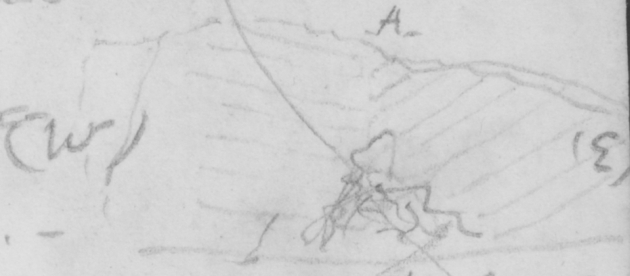 |
[cliff with talus?] (W) A (E) |
The point A separates all the westerly dip already described. —
The Easterly dips, will presently be described. —
The whole of these sedimentary beds & the crystalline are traversed by a remarkably system exceedingly numerous of metallic veins; the base would seem to be iron; they seem
[page 172a]
generally nearly vertical, & forms intricate net works. — They contain gold & silver in disseminated particles (46) in specimens of such veins said to contain a little silver; the effect on the strata to a considerable distance is remarkably (indeed whole masses of strata) being blackened hardened, & heavier; the effect is most palpable in the white sedimentary rocks (47: 48: 52) will give some idea of this: The appearance of is of a shattered rock all the fissures burnt & blackened by metallic fumes. — We will recur to the subject: With respect to the crystalline rocks, interstratified; the appearance of the junction, although not quite even, being rather blended is certainly not that of injection: none of the crystalline rocks show any signs of aqueous deposition. — I firmly believe they are a succession of Lavas subaqueous time of clay Slate most ancient !
[page 173a]
(Mem: Toadstones of Derby); [infiltered] with aqueous deposits; altered by fumes of metals; & as I shall show probably have undergone, during time of tilting great heat. (also greater alteration of sediments near the crystalline rocks). It seems a bold conjecture I firmly believe a true one. == To return to the section at the beginning of this day; above the highest augitic bed, I believe there are to the west several more alterations. I had not time to examine. — From the point of fault (or synclinal line), for a mile or two to the west, we have similar beds all dipping at small ∠ 20°-30 to East — till we come to the highest Eastern ridge of the mass of the Uspallata range.
— a height I should suppose at least 7000 ft; — we have beyond this a tract of undulating country, of no great irregularities, with broken dips — excepting two or three great mountains of Granite; the one which I examined consisted of white feldspar, with
[page 174a]
crystals of Fel black mica & Hornblende (32). very little quartz; similar to grey granite of Portillo. — another great granite mountain [base] NNW of this (The granite contained veins of Epidote). Rock granitic form & appearance). — These mountains are coated around their base by the white rocks, tracts of which are singularly blasted by the metallic fumes (31): The very highest gravel mountain is capped by a stratified mass of strangely altered quartz, [flaky] & Jaspery rocks — These are traversed by thin dykes. of a fine grained granite? of which & the altered sides (33): in only a few places in [the] cap could I trace the white aluminous sandstone so as to recognise my old friends, indeed in the plain, there were black jas siliceous stones, which may be owing to altered
[page 175a]
Clay-Slate: — To the West of the granite mountains in the distance a fine westerly dip is visible, we have seen an Easterly one on the East side: grand anticlinal bands — It is in the white rocks & underlying granite where all the best mines are worked: the main veins appear all to run within a point of NW & SE. — They are excessively numerous chiefly auriferous. — The first I examined were high up & in the granite: The veins [vitus] were about a yard wide & composed of several such rocks several mines (34); in these are included the ferrug. = aurife. gias1 of which (35) are specimens of size of best quality it is worked in a crucero. — (The Boque mine) Some hundred yards lower down, amongst the curious white rocks (& entirely overlying the granite) (36: 37): there are auriferous veins (V 38-41): Also one of copper. Further the westward there are silver mines & northward Copper ones, said to occur in same
1 Veins.
[page 176a]
kinds of rocks. — It is manifest all the metallic veins come from underlying granite. — There can be no doubt the granite, breaking through the clay-slate, has tilted & uplifted these beds, as at the Portillo; the age has already been presumed the same. — the metallic veins are probably connected with heat of cooling granite:
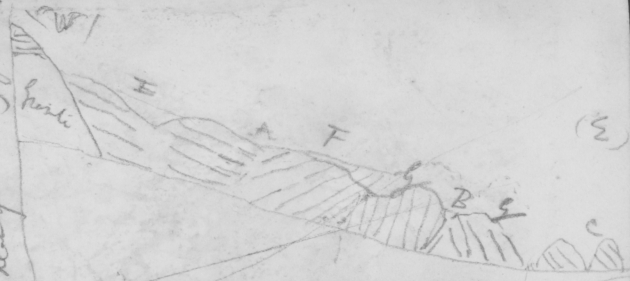
Granite (W) E A F A B G C (E)
E white rocks dipping East (A) sunclinal point (F) white rocks dipping W; Lying upon the clay slate (G). (B) [Portillo] anticlinal line in clay slate & grewwacke (C) outlying hills apparently dipping (E)
perhaps from color containing some "white rocks". —
[page 177a]
April 2d [1835] road to Uspallata. —
(55). What I called Pitchstone in patches I believe is Lignite1
(56) A common sort of trap-Lava as in W [slope]
(57) Vein in Lava & Sediment. —
(58) Green Sandstone of trees
(59) (60) 2 common varieties above
(61) uncommon do. — do. —
(62) Piece of tree so much altered not to be recognised
(63) Metallic dyke near Trees
(64) Augitic lava above do beds
(65) Blank Laminated flinty slate minute traces of organic remains
(66) Brick red bed with pebbles small
(67) Bed of Lava
(68) One of the white beds
(69) Grand Porphyritic dyke. SW & NE Rode from the Hornillos to Uspallata: fine view of mountains: curious colors = Avecasina: several parties —
1 Fossil wood turning to coal.
[page 178a]
Summit of Uspallata range is, as I have said, capped with Lavas & Sedimentary: on the west side, the dip is constantly westerly within a point: the inclination of any line of strike, not being constant for any great distance: ∠ from 20 to 30. = I saw one spot about 45°. = The Lava on this side seems in greater proportion: has more the appearance of Lava. — spherical structure: chiefly black sorts: the junctions are quite distinct, ie the superior ones (56) is a common variety. I found both it & sediment, traversed by vein (57) (what I call the Sandstones, are never true ones: cemented by the white substance generally variously sized particles;) I found a considerable quantity of fine layers of less glistening Pitchstone: & a good deal in patches in layers (55). I believe Lignite in layers & bituminous shales; also single isolated angular patch in Sandstone in other locality: Looking for silicified wood found in broken escarpment of green sandstone
(58) 11 silicified trees & 50
[page 179a]
or 60 columns, (Lots wife) of Sulph: of Barytes:1 [drusy] cavities: form completely [straight] either entire silex or Barytes: nearly all same diameter; little more or less 18 inches: in silicified centre of tree evident & all the rings: impression of bark in Sandstone: in Barytes only analogy makes me know what they are: the 11 are within 50 60 yards of each other: the most remote not above [120 ft.] no where else, did I see a trace: The strata incline 20°-30° WSW: All the trees incline about 70° to ENE: I expect 2 silicified pieces as thick as my arm & smooth which are imbedded: horizontal: trees some trees only a yard apart. many two or three: appear vertical: Barytes one traced seven feet: silicified 4 ½ ft: sandstone consists of many layers in color & texture. which embrace trees: In sandstone vein of Sulph. of Barytes. 37 & in other place. nodules of agate: few fragments of Volcanic rocks La Green Sandstone, covered superiorly by brownish ones (59: 60) & compact purplish ones, & contain some odd
1 Barium sulphate (a heavy white mineral).
[page 180a]
varieties (61) (NB one tree converted into column of stone without structure (62)) —
These varieties rather pass into each other & are not very constant in their position:
The Sandstones may perhaps be 4-500 ft thick they repose on Lava, are capped by immense conformable bed — 1-2000 ft thick of black compact Lava (64). Looking to the west. I could see at least 5 grand alternations several 100 ft thick of these such [two] formations —
close to the trees there is a broad metallic dyke, which runs NW (63) affecting the strata — I saw other close beneath the Lava: in a brownish sandstone an infinity of parallel threads curved which united & parted in groups. — Another in the green Sandstone has been worked, from situation gold or silver which runs nearer E & W.— situation before Agua del Zoro: & before the ruin [by mine] S. side of road: — Still following down the valley we have jet black fine Laminated flinty. slate (65) by wetting one side traces of organic remains will be visible: between the layers,
[page 181a]
concretionary lumps of same substance occur. The layers are curved & seem to follow over uneven surface of Lava: I may mention in all the following less altered beds a ringed or concretionary structure is evident: In a coarse brown sandstone, fissure brown rings dependent on them on large scale as at Chiloe: I mention a few of the more remarkable varieties in the alternations: quite white bed, soft with particles of quartz, like in Chiloe &c: those compact kinds, as with organic impressions of yesterday: a great quantity of extraordinary red: crumbling substance (66) which lay upon a brown substance & alternated with Lavas: I here first saw an [interlac] [nest] of Volcanic dykes, traversing Sediment. Near a mountain hill chiefly composed of Volcanic rocks & higher than stratification render probable perhaps eruptive: 200 100 specimens will not show all the Lavas): a red conglomerate of crystalline pebbles as large as nuts: (67) bed of Lava, by the Agua del Guanaco. — Again beyond this we have quite white sedimentary beds (68): As far as Agua del Guanaco
[page 182a]
the dips, with few & little irregularities had been Westerly; here a line of low hills dipped due East a valley & beyond some higher ones west; these had a ∠ considerable from 45° to 70°: a N & S line of Elevation at western foot, as at Eastern: (NB top of granite hill at least 8000 ft): the last low hills, from very limit of plain of Uspallata: a little to the South there is great irregularity to the dips apparently owing to oblique lines of elevation: one of these (in the road) runs about SW & NE & seems caused by grand dyke or chain of hillocks of a Porphyry (69) which seems injected amongst white stone (68). These dykes probably anterior to the Granite: To the South, hills all highly inclined strata some nearly vertical, great confusion Hills much water worn — conical view, white, black volcanic red crumbling: purple green Sandstone Lilac injected Porphyries: every shade of
[page 183a]
brown — Valleys broad1 & flat: a mere furrow present water course: enter grand inland plain of Uspallata: to North nothing beyond
horizon. — April 3d. [1835] — Uspallata ½ the day (70) altered clay
slate: (71) compact purple Porphyry — injected in do (72) White do mixed with latter: these north of house Uspallata
(73) altered, almost crystalline slate:
(74) (75) injected Porphyries in do. —
(76) Sheet of Lava over the Slate
(77) Sedimentary bed above in same section
(78) Silver? ore from last slate, said to come
(79) — Argentiferous2 lead
(80) Gold ore also from mines of Uspallata: NB Porphyry in the road Before arriving at the house: the plain is bordered by a band of clay slate, with veins of quartz; cleavage vertical, or lightly inclined dipping to the East (NB. Salitra at the Agua Guanaco: Porphyries on the road S of the section): The Slate, exceedingly, harsh sonorous
(70) brittle, laminated, but the laminae not fissile; some partly crystallised
1 According to Sulloway 1983, p. 364, this is the first instance in which Darwin spelled 'broad' instead of 'broard' during the voyage.
2 Containing silver.
[page 184a]
(like 73). crossing a N & S ridge the Slate became green & purple, [splintering] & was succeeded by band of soft-purplish Porph (71): generally much softer than specimen, this is mingled in veins & large masses of a soft white sort (72) passing without any rule. — the junction is nearly straight. I did not see point of contact; & was much puzzled; there seems a dip of whole mass to the East; following plain to the South: the slate is seen on the East side; & the formation of Porphyry is shut in to the South: at mouth of pass of Caviota, a broad flat valley by degradation exposes extraordinary scene, a cluster of Porphyry hills of all colors distinct & blended from dark Porphyry, lilac to quite white & yellow, of the latter (74: 75 Specn) these have burst through the slate (V map) or through a mass of slate fragments, which seem to have overlied the slate; they are firmly cemented together: domes of Porphyry underlie
[page 185a]
these rocks; others are capped by them. I found one mass of white, specimen, Porph inclined at about 80 70° on a mass of fragments; it sent a small vein into it. & the sides were marked by the indentation of fragments some of which could be extracted, other broken, remained in — The rest seems to have hardened the fragmentary mass. — These hillocks from basal parts of (& evidently near point of eruption) a line of strike of grand mass of beds which dip to NE 50°60° — These beds consist of almost same Porphyries, but are evidently Lavas separated by layers of Sediments & lying on the slate & subsequently upheaved instead of bursting through it: The slate forms a triangular mass, is all composed of a greenish almost crystalline kind (73): quartz veins: cleavage NE: SE: (upheavals): bands of Grewwacke also altered: In the Slate said to be silver mines. Spec (78): To the South, there is a corresponding immense escarpment of Porphyry Lavas, dipping to SSW, instead of SW ∠ 70°
— thus the two lines of strike
[page 186a]
are not parallel, but converge: Beyond again Slate mountain — Plan will show best. — This escarpment looked exactly like the painted Geolog. sections of mountains: I omitted in the very intervening slate mountain: 2 points of purple & red, show injection. — To return to first escarpement, describing from Slate, a pale purple rests on red breccia. full of large green fragments of Slate, on a pure Breccia of Slate (as in the injected hillocks) or on the Slate itself: above this a very heavy compact Lava
(76) sphaerical structure a great mass of purple & these curious white masses of Porphyry, divided into some divisions: a thin greenish (77) white sedimentary much stratified mass: grand quantity of cream slightly columnar — colored Porphyry, divided into three divisions
— (dyke crossing obliquely the sedimentary bed): a grand mass of the Lilac & white Porphyries: In the injected Porphyries veins of Cryst. Carb of Lime.
[page 187a]
do not differ from the Lava: in some Brecciated structure: never conglomerate, different aspect from. Brecc. Porph: appear more of one sort: It is clear, Porphyry has on a N & S line, burst through Slate has overlaid it & alternated with sediments, has been upheaved in a point (Granite hill) by the Slate which is altered: Although some outburst has taken place here: main situation on E true slope of Cordilleras: The Porphyries extend far East, amongst the Slate hills.
— Argument that Clay-Slate, distinct form (& Slate hill here): — // Uspallata mines. between (79) the 2 road; in clay slate: gold ore (80) like Hornillos at least equal probability belong to Tertiary period we have seen the injected Porphyry is subsequent — in some cases to the Tertiary form:) The Grand S — Escarpement does not cross the river:) Plain, islands. — water worn hillocks: alternations of white & bright red sands; slightly agglutinated, with lines & masses of pebbles; of the green altered Clay-Slates Porphyries & Granite: (surface scattered over with pebbles, much protogene) Beds dip
[page 188a]
all westerly 45° or more, with some irregularities capped by great beds of horizontal gravel, which near river is universal in enormous barranca: subsequent residence of sea — which side did the altered green Clay Slate come fom? — Pebbles, size, nuts,eggs 2 fists —

(B Alluvium in plain) W B A A Lava & less inclined sediment Gra E
In morning rode to mountains; old kill Christ not very civil, after noon crossed plain entered grand valley of Cordilleras; side of river of Luxan. much larger here, than there: sudden fall after sunset: extraordinary colors after sunset;
In this plain Ostriches, Toco Toco. Apereas Pichy Paluda — Extremely sterile. —
 |
[Grand valley]
|
The lens shaped red covering from grand valley of red Porphyry: over true horizontal gravel of Barranca of River
[page 189a]
Extraordinary confusion, from injected Porph. Lavas, Sediments & Alluvium, all most brilliant colors. —
April 4th [3 April 1835] (81)
Protogene like Porphyry: (82) altered slate with pebbles. (83). much altered slate (84) Fragment picked up near junction of granite & slate with crystals: (omitted faults in sand alluvium. Slate exceedingly contorted in the intermediate mountain: also at the Portillo, white Porph dyke in micaceous sandstone). With respect to last little section: must have been some general cause separate from the excavations of each valley: could a debacle, round so many pebbles. leave horizontal bands of the finest white sand, white-wash pebbles: cement the with Carb of Lime. This last fact noticed in high valley of Maypo: — started early; gale of wind, fine barren valley: only one resinous bush. not so lofty or so barren wild as the Portillo road. — Bad passes; could walk backwards: was told to carry thick Worsted stockings: if mule stumble probable death no chance1
1 'I have been quite surprised at the degree of exaggeration concerning the danger & difficulty.' Beagle diary¸ p. 318.
[page 190a]
had to unload at P. las Vacas; 5 £ expensive repair pass: not so on the Laderas: found Estero de las Vacas too much water, alojamiento,1 there; no pasture for poor mules: before arriving here crossed a Pass of Jaular, the worst I saw considerable hill of Alluvium, is the Paramillo, (dead animals exaggerated) tuft of grass in mouths Juan [Pobre] Bushes to the top: not many parties: — Valley Cajon of Luxan, enters Cordilleras almost N & S bends gradually SSW — SW, till we came to the Estero de las Vacas; thus in the section too much of each form: is seen. The mountains on each side of mouth, seen at distance, form an enormous platform 2-3000 ft thick, cut by great square valleys: consist of a strange mass of various colored in patches of Porphyry which appear rarely divided in strata. perhaps by sediments such strata incline at very small ∠ to E: all colored Porphyries seem to have been injected into
1 Lodging, or steerage in a ship.
[page 191a]
each other; interlaced by grand, red dykes: a dark hill of rock, was backed, as if split & filled by which rock, which sent off dykes, branching ∠ 45°, thinning downwards, rare case. —
[dykes?]
inferior: appear sometimes
| Where valley bends a little more westward, we have on north side a grand range of peaked mountain, sometimes reaching over to the South. rock is Protogene in a basis of Porphyry (81): is intimately connected with the pale porphyries, but almost always |
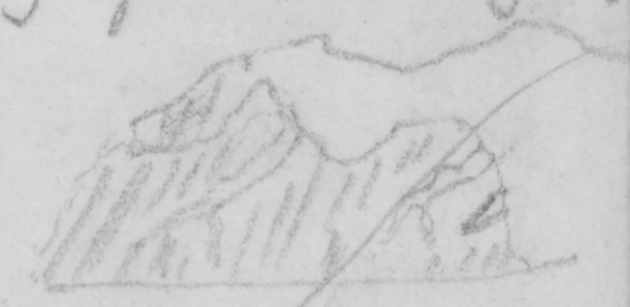 |
however to be injected with white sorts & even
stratified; one place, where closely joined on to white Porphyry, the latter almost consisted of its own fragments joined by fire: on the south side appear chiefly to consist of stratified Porphyries, which apparently have flowed: I cannot doubt these sections are the basis of band of volcanoes, from which
[page 192a]
the stupendous streams of Porph. Lavas have flowed: scale of chain of Volcanoes. there would be cones of crystall: rocks which have not flowed: — In a pass beyond the Jaula; first clearly noticed. Porphy. Breccia — certainly different, although alternating with white beds; these blended into each other: many parts could not be told from the injected, but the large round, distinct pebbles; not only round, but if those various, rounded many sided fragments which we see on beach: pebbles [illeg] [4] sizes of being arranged in bands — Claystone or Jaspery parts with no or few crystals; masses of green Porphyry with narrow bands of purple, brecciated sort, a stratified structure & general aspect Porph: Greenstone dykes: I am certain these are injected ejected & baked Porphyries in these
[page 193a]
Cordilleras to be distinguished: These Porphyries appear tilted on each side regularly by a SW & NE line, hence Valley. — They are traversed by grand dykes & masses of Porphyry, so only remnants of the ribbons of escarpement remain: I saw large mass, which had thus burst through the strata, of a white porphyry. it self containing dome & dykes of a compact reddish black Porph: in the form of fragments cemented by fires: & this again traversed by Porph: greenstone dyke: Consider the confusion. — At the Pass of P. de las Vacas there is a great hill of Protogene Porphyry: thus also. upbursting: — From this Point of the R. de las Vacas, we have clay slate, underlying the Porphyries (Valley rather more W than SW): at first, the clay-slate is somewhat similar to that of Uspallata range with vertical contorted cleavage
[page 194a]
we then have it more crystalline (83) from which it passes into true greenstone with grains of quartz. Cleavage even yet perceptible sometimes, about NW & SE: judging from fragments there is very much, conglomerate, whited by same cement, as pebble (82). most undeniably true pebble: specimens show state of Slate, a degree more altered than at Uspallata: Specimen does not show Conglom: struct: quartz veins: Slate traversed by some dykes & masses of soft white rock; after riding for a mile or two at the base of such hills, we find true granite. white, but rusty by air (traversed by green dyke) underlying & protruding into the compact altered Slate: capped by the B. Porphyry joined by net work of dykes: at base of extensive junction, grand fragments of granite, containing almost composed
[page 195a]
of fragments of green crystall: rock, joined by granite, as in other pass. Porph Breccia = Saw amongst fragments at base, mineral (84):
 [valley of Luxan]
[valley of Luxan]
NW P.B Slate granite Valley of Luxan Luxan P.B X Porphyries Lavas & sediments A alluvium R de las Vacas This section is imagined to be east & west across the mountains, between the Punta & R. las Vacas: the dips are uncertain & not to S & W, but perhaps NW & SE: the part of section (A) is of course further to the North — (x) contorted injected hills of Protogine Porphyry. — I omitted to state. I conjectured I saw Lavas over the P. Breccia where first met with. — it is clear that Granite is the axis of the slate, & that the Protogine Porph is only accidental & concerned with Volcanic emission similar colors in injected, ejected the source baked sediments, alluvium, Porph formations:
[page 196a]
Section of mountain S of Puentes del Inca — 2000-3000 ft high. —
April 5th [4 April 1835]
1 2 Lowest bed I visited is a coarse white conglomerate: many particles of quartz, almost blended together matrix not Porphyritic: There is to the W a lower bed. doubtless conglomerate:
3. White Sandstone, very quarzose, almost [quartz] forms conglomerate or sandstone 4) Red Bed & white bed not visited 5 owing to talus & want of time 6/85 yellowish fine thinly stratified Limestone nodules sometimes [domes] of Carb of Lime: figures like shells sometimes 7/86 20-30 ft Feldspathic Lava 8 Same as (6) more compact, part stained purple. — 9/87 dirty purple, partially crystalline rock amygdaloid with Carb of Lime 10/88 [ridges] red sandstones covered by grand bed 300 ft of coarse red purple Conglom pebbles — nut to mans head: all red excepting white quartz: the coarsest I have ever seen in Chili
[page 197a]
10 contains a bed of white Limestone? in centre 11/89 Grand wall of Feldspath Lava (highest part of section seen from the Puerta): upper parts cellular lined with yellow: This perhaps is about half way up the mountain 12/90 a crystalline dull red sandstone which passes by 13 compact red Sandstone into a very coarse white conglomerate base chiefly particles of quartz 14 Alternations of conglomerate, compact red sandstone & such as
(12) & much (9) 15/91 Greenish crystalline Sandstone 16/92 Many strata of compact or more laminated red sandstone
17 Gypsum 18 Red Sandstone (as 92) & layers of white Lime (93) 19
These strata all dip about 30° to W by S in some places 45°. They are traversed by many faults. The lowest bed of Conglomerate & white lowest Sandstone is most altered, or rather the same = Porph. fine grained Sandstone: all are compact
[page 198a]
& have undergone action of some heat. but I have seen none so little: on the north side of valley, the lowest red beds are seen on the altered Slates: There is no passage to the two beds of Feldspathic (with mica) beds: I can have no doubt they are Lavas: the passage of the Sandstones & those same Porph Kind is certain & proves heat: At the foot of mountain much white Limestone with impressions of shells. did not happen to hit on site: The gypsum is precisely like in Valle del Yeso: concretions of white marble & others lined with black. — coarse crystals — lines of the black crystalised: Gypsum apparently in lines with Lime & Selenite & pure soft light Gypsum: The intervening & capping rock is curious specimen is not fair, because laminae are generally more even: like the contorted layers with green sandstone
[page 199a]
in the Valle del Yeso: (This rock forms some of the very highest points): The line of Strike of these (N by W) strata is very important & forming some of the highest hills: in this very line hot springs (& much gaz) of this Puente issue: — To return to the R. de las Vacas. from it to the unison of rivers we have much altered Conglom & Slates penetrated by whitish Porphyry: & this extends some way up where the road bends to the N of W: near the Casa de Pujios: S of river granite is seen, in paps upheaving the altered slate, & superincumbent strata, (such as section, NB. section illustrates in [color] place where the P. Bre. was seen in this pass) & tilting them to SW, from this they curve to the above grand dip. — Now [from] the mountain to the S. & N of this basin of [illeg] the colored strata are seen horizontal forming, enormous snowy mountains, & here we have simple conglom: these Porph. = Conglom. I
[page 200a]
must remark, that size & much rotundity of pebbles in two states
quite agree: — To the W. then at last section we have this. —
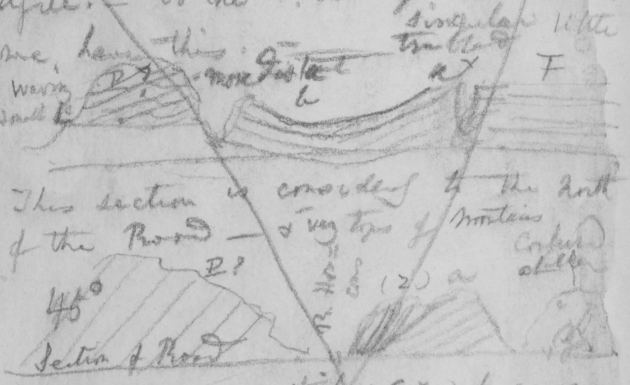 [curved strata and section of road]
[curved strata and section of road]
singular little troubled waving small ∠ D ? more distinct b a F This section is considerably to the north of the Road — & very tops of mountains 45° section of Road D? R. Horcones (2) a confused [altered] (aa) part of same strike (a x) of course [most most] lofty (2) strata inclined 70° instead of 30° as rest of mountain. (a) is the same as section seen on N of Road: The horizontal strata is very lofty ridge very unusual. — The part a F, can also be seen. (b) removed by valley of Hercones. Some way south of road: — Have forgotten — I think each Gypsum bed & intervening bed 300 ft each. — Rode for half day, to the Puenta saw, humming bird, & Lion, long billed Thrushes
[page 201a]
Red breast creeper — Bushes, at least 1000 ft above Bridge: ascended mountain without very much Puna 2-3000 ft: tame ride large valley & much Tufa, over alluvium. — Yesterday, several groups of Indian huts, look as if great party had migrated & been obliged to stop for some time in most barren spots: doors very low. 3 ft huddled together, square, — passed 2 Casuchas. — Mules, pass rivers [but] with riders argument against "Rational". —
(April 6th) [5 April 1835] I do not believe Strata above Granite above
6000 ft: the upper Gypsum strata removed on outer parts of Andes. — Incas bridge irregular hilly plain of valley filled up with pebbles & detritus
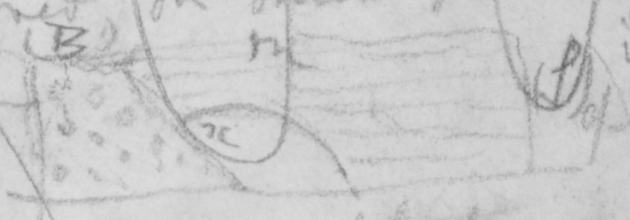 |
[Puente del Inca] (B) x (S) |
a fan of ferruginous cellular Tufa covering a part: the river having cut as far as (x). continued to scoop out to the Southward; rubbish (B) fell down from plain & supported
[page 202a]
(m) whilst river, continued forming arch. — the oblique junction is very evident (horizontal & confined) plain generally horizontal gravel this not so; hence rubbish: — My hypothesis of Tufa is that it was deposited after valleys excavated & just before sea retired; matter before that generally deposited —hence Tufa from these
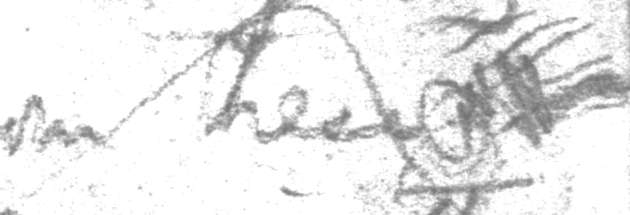 Springs extends above
Springs extends above then leve in the slope, above their level: Springs hot — violent emission of gaz:
Concretions, where water drips, in heaps Guanaco could not well descend there & Springs above: — Travelled to day to below the Casucha of Jununcillo [looks] curious, miserable dungeons: very cold wind, no bushes by C of Cuevas or Calaveras: road crosses no snow — I should think the Portillo rather higher
[page 203a]
view not comparable: — Amongst enormous heaps of debris, especially Gypsum, large & curious funnels: Strange forms of Heaps of blackened fragments of Porph Brecc; have given name of Crater of Paramillo de las Cuevas In last great section, beneath Bed (2) we have thick bed of a true, reddish dull purple (common color) Porphyry, coarse & not well crystallised, yet a Porphyry is very obscurely brecciated (97) has in its upper parts [lines] [illeg] contains small pebbles, matrix Porph: above this we about 80 ft of a compact grey Limestone, almost white; lowest bed a conglomerate of Limestone; contains bands in all parts of cemented breccia: lower parts all fractures weather red (99): upper parts yellow: (NB. in Porphyry vein like lines of Cryst. Carb of Lime). most obscure marks of Shells; on plain fragment of same sort
[page 204a]
of S. Stone, with more perfect generally a trace of gryphite1 (100) the most perfect shell an oyster (101). There was a white Limestone with line of little quartz pebbles — white or red, like shot: — above the Limestone same thickness of same color harder heavier (than those above) Conglomerate, matrix with slight trace of crystal (98). above this I believe Limestone, which [on] the first contains a hardened blue marl (102) with nodules of Limestone: we then have (Bed 2): I doubt whether this other is quite constant: also, whether [1st] Porphyry immediately covers the altered Slate: — Above the highest bed described I see there is again Gypsum, again white & red in lines, containing large bed of green sandstone; all the neighbouring highest summits are thus formed. the quantity of white lines
1 Fossil oyster of the genus Gryphaea.
[page 205a]
in the highest cap being variable: To the West I noticed important fact that all the various red beds above main Lava (N B. this bed variable in thickness) which in section contain no gypsum, receive wedges of this substance, so that at last they are entirely lost & replaced by mass of gypsum: so that one end all red beds at other all white: whereas some of the upper gypsum beds seem converted into a yellow sandy Limestone (103) & some black, traversed by thin ferruginous veins: I think whole section above granite at least 4000 ft — & gypsum formation above the main Lava) above about 2000 ft: — Excepting the Cumbre & altered peaks of P. Breccia all seem composed as thus shown — The proportion of Gypsum & Red stone never remains constant but always superior
[page 206a]
no 1) South of Valley
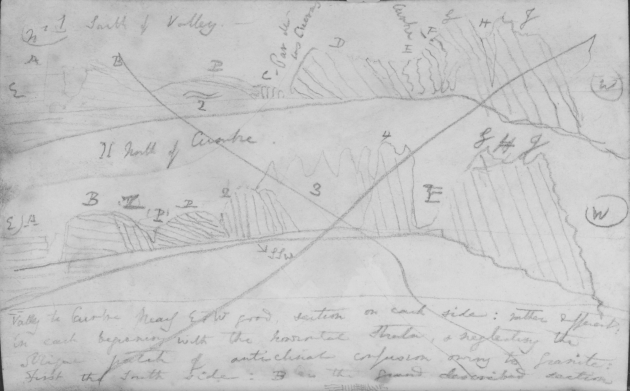
[section to South of valley and Section to North of Cumbre]
E A B P 2 Pas de los Cuevas D E Cumbre F G H J W II North of Cumbre E) A B (Z) (P) P 2 3 4 E G H J W SSW
Valley of Cumbre nearly E & W good, section on each side: rather different: in each beginning with the horizontal strata & neglecting the oblique patch of anticlinal confusion owing to granite: First the South side: B [has] the grand described section
[page 207a]
the dip being from 25-30° & beds great thickness & some faults, (∠
25. thickness 4000 ft how long would the horizontal section be) — We have the upper strata forming the hill (P.) of Gypsum &c. — Here there is a bed of pale calcareous Sandstone? (103): In lower part will be seen a patch of contortion. this will be mentioned in section to North of valley. At (C) we have either injected rock, or I believe vertical strata: Beyond this hill (D) dips at about 45°. to W by S, is composed of slightly Porph. Breccia & the Limestone: ∴ lower beds. more altered than the section: again (E) consists of red thin layers of Sandstone & Limestone (104) which do not appear to belong to hill (D) are vertical & contorted each way, chiefly however dip to W. traversed by extraordinary system of inclined & vertical dykes. green yellow & red. — the Cumbre passes obliquely over north margin of this (F): upon this rest dark purplish Porph. B. again a whitish sort: to the west of this, to the Casucha of Calavera, there is a grand mass of altered rocks, forming where road
[page 208a]
runs, by excavation, on double row. apparently dipping to the West:
Section to the North: Between B & P, parts of same of dip, is the valley of R. Horcones. where a patch of 70° W dip has been noticed connected probably with an Easterly dip seen to the north in distance:
— The 2 P's: similar. Beyond this, we have mass of strata dipping from 60°-80° running to SW up the country to some distance; the S. point of this line has caused, the contortion S. of valley. Behind & to the west of this there is a E & W range of lofty (as Cumbre) rugged peaks formed of Porph & Porph. B — with little stratification (hence valley full again of Crystall fragments) (hill 4) a [tight] W curved dip is clear, corresponds to (D) but much more altered. these dark Porphyries are threaded in extraordinary manner. by grand dykes & very white Feldspathic crystalline
[page 209a]
Porph: — (might well come from the white syenites) This trouble & the Porph. nature of conglom: again well agree. — The valley of Luxan corresponds to (E). The Cumbre similar excepting there is not an intermediate valley ravine of excavation: These hills very much altered — dykes high dip where seen — Probably (E) as (C) marks distinct line of upheaval — But I do not understand these hills. — at C of Juncalillo we come (from depth of ravine, no other cause) to the white syenite, with very little quartz — which has played devil with a line of N & S hills, which appear capped by remnant of Gypsum form, dip small ∠° W a — (Probably Gypsum f. has been removed from ridges of the Cumbre) — Ridge clearly N & S. — // Remarkable electricity in high regions: shirts, sheets, leather straps: dryness — lips, heads, of hammer = absence of Vegetation & dark color of sky, transparency of air
[page 210a]
three great features cloudless owing height; colors of mountains to Andes: airy [in] everlasting look. The ranges certainly run to the W of north a little: In the W Cumbre range perhaps some injected Porph; there is much true dark greens & purples: extreme regularity of weather: small Cumuli such as seen from S. Cruz: — Valleys owing to Stratification, but immense removals: — immense degradation & consequent talus striking feature: arguments of length of world from deluge applicable in each part since sea retired: Alluvium at Puenta del Inca, filling up base of valley has lost regularity of outline: rivers only constantly remove small pebbles & grind to dust large ones: Excepting high up it is rare to find the rivers deepening the solid rock: Silicified trees in nearly same level. I do not think above 20-30 ft diff:
— Perhaps beneath escarpement. roots: no [lines] to the foot:
[page 211a]
April 7th [1835]: Half day — lost mule, to the old Guardia —
Between this & the ojos de Agua — Chili begins with dotted bushes & cylindrical cacti especially at latter place: rather pretty — the range beyond Cumbre at the Juncalillo is just capped with Stratified Strata: We then have at the Ojos, a range of altered rocks supporting great mass dipping 25°-30° to W of various white purple, red, harder softer more or less porph. more or less coarse conglomerates: — Part of this range appears to dip NW — (hence perhaps valleys — This is at the Guardia
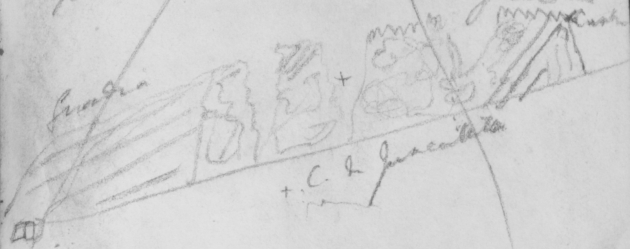
[section of Juncalillo] [W] Guardia + C de Juncalillo [Jacuncillo] Cumbre
[page 212a]
The petrified trees (taking inclination of Strata into consideration very much on a level not more than might well happen growing on a plain. — 20-30 ft above road — so that I suppose they grew in same sandstone, but confess I am not sure, did not sufficiently examine — of course soil would be much altered carbonaceous matter removed, silex deposited. — perhaps — 100-150 yards apart most distant ones — Lava examined to the North — The great bed perhaps 800 ft thick seen further to the South: not lake — great changes to make unmake remake
[page 213a]
again — similarity with marine deposits — Form of land before upheaval not admitting one & the Lava having flowed from the W — being then thicker. & Volcanic dykes. — Perhaps section of a large wood — No trees in the reddish Sandstone above at a short height Believe the strata below to be same varying Sandstone [as] described above. — Beneath volcanic rocks & Lava all conformable (plain of Uspallata two Entrances) but do not know the very variety. — Not lacustine: because we see plain at near V. Vicencia marine nearly same elevation as Uspallata —
[page 214a]
8 7th [April 1835] lost whole day — hunting for mule
9th 8 8th [April 1835] To the W of the West dip at the old Guardia: another mountain much altered capped succeed on West side by same stratified mass dipping to West: very many dykes: some of them white I believe granitic — Beyond this mountains with little stratification, based on white Porphyry, which passes into true Syenite fine grained with quartz very abundant like Cauquenas [Portillo] — some little hillocks in the mouth of valley — the lowest rocks near mouth of valley to [day] were chiefly greenstone Porphyritic, owing to Slate? Saw no where high dip or Easterly
[page 215a]
one — very tame scenery — Valley of S. Rosa — certainly looks very flourishing after the stony mountain sides — I suspect whole side of mountain one dip, with some faults & much altered: — White dykes of Mr Gay — not quartz: but then Porphyry so similar in constitution to Syenite. — as Protogine Porphyry to Protogine (105) in specimen of this Porphyry with angular blacker patches of included rock: flat valleys — all forms of dykes peculiar to Andes: — (Big Rat1 of Aconcagua in high tree: — If the sea has covered the base of the tilted strata in Uspallata. it surely must have done so before upheaval: —
1 Specimen not in spirits 2207 in Zoology notes, p. 406; listed as Abrocoma bennettii in Mammalia, pp. 85-6.
[page 216a]
Rather if we prove the sea has [bee cone] covered to within 1000 ft of these upheaved Strata: surely [it] must have covered them before doing their tilt. — Cleaveland Geology of United States: in upper parts especially of Alluvium with shells & sharks teeth beds of gravel. P. 6381 Primitive formation generally incline to SE at gr ∠ than 45° Pyrenees 1763 Toises — St Gothard 1431 — M. Canis 1807. — Height of Patillo — Caldcleugh P. 3102 Calculated from Humbold[t] 12.800
1 Cleaveland 1816, pp. 638-9.
2 Caldcleugh 1825, 1: 310. gives 12,800 feet.
[page 217a]
Prussian voyage round the world 1830-32: Some time in Chili Mine: Saw Pedro de Nolasko runs E & W: argentiferous lead copper — Silver &c. V. Specimen Mr Broderip1 — has shells from from Coquimbo given by Mr Caldcleugh Shells at Illapel
William John Broderip (1789-1859), barrister and conchologist who assisted P. P. King with descriptions of molluscs and cirripedes from the first voyage of the Beagle in Narrative 1: 545-56.
[page 218a]
All the days are wrong from their being 31 days in March days
Reached St Jago 10th (owing to 31)
11 9th [April 1835] From the Villa Nueva to to near Colina. —
noticed that [certainly] the Porph. Greenstone & greenish Porphyries are more abundant here than in the Cordilleras owing to Lowest bed of Slate: (NB Mem: Limestone of M. Gay distinct from Porpico) (All this time to Valparaiso not quite well saw nothing enjoyed nothing) 10th [April 1835] From Colina to St Jago pleasant city — Mr Caldcleugh nothing but the Porphyries on the road—
(15th) [April 1835] Started for Valparaiso — dead mens heads on
[page 219a]
the poles. — Mr Caldcleugh says veins run NNW & SSE. — but in thickest part of mountain = better near the surface — upper parts Carb of Copper — [thick] in Crucero = richness of = Anthracite found in the mountains The very first ranges of low hillocks to the W of St Jago, consist of the plate-like Porphyry mingled with an amygdaloid rock almost composed of Epidote (106) — These hills a little more to the Westward contain & N &S N by W & S by E veins of Copper which has been worked for few months: At the base of the C of [Prad] we find
[page 220a]
a soft decom strange mixture of rocks of harsh nature & generally in very decomposed state (107) & these rocks contain an infinity of veins like masses of decomposing Trappean rocks some of them Porphyritic (such as Z d Z d). At the foot of the Zapata we have the decomposing gneiss ( — mica generally replaced by greenish mineral) with large concretions — This occurs in all parts & makes me suspect that the (107) rocks supply its place — This rock is traversed by many veins — like dykes of Trappean
[page 221a]
rocks — which differ from most injected ones I have seen in splitting & uniting in many thin ones — & in one case sending off a long vein which thinned to nothing downwards. — The gneiss [clearly] [included] is altered: yet I am quite in doubt concerning the nature of these dykes. — Higher up we have an infinity of veins which like quartz veins appear contemporaneous of which (Z) will show specimens I remain in doubt is there a gradual alteration from
[page 222a]
the gneiss of the low countries to the greenstone & Trappean rocks — important point overlooked Elmis & Colymbela warm spring of V Vicencia
Cicindela — Saline banks of river of Estacado1
Buprestis2 — Curculio — Traversia of Mendoza — : Cryptocephalus Chili 600 ft
Bembidium3 Mendoza —
 |
[plant leaves and doodles?] |
Coprophagous Traversia Mendoza abundant
Heterom do & [High] East Valley of Andes —
1 Specimen 2841 in Darwin's insects, p. 89.
2 See specimen 3227 in Darwin's insects, p. 90.
3 See specimen 1025 in Darwin's insects, p. 71.
[page 223a]
Was told at Mendoza large bone found at Los Gigantes & R. Quinto — Mastodon — Paraguay Sediment of Uspallata. regaining crystals of Feldspar curious probably owing their origin to degrading of Feldspathic rocks Thick bed of shells at Quinquin mentioned by Frezier1 as about 200 ft elevation Frezier remarks that Llama & Guanaco dung in heaps, useful for fuel for Indians. —
1 Frézier 1717.
[page 224a]
Biscatcha, bones & round holes foot of Pampas = Close to the mountain Biscatcha = Ostriches Peecheys in Uspallata [Huming] Bird plentiful Valparaiso
April 20th. [1835] — Saw first on road for St Jago — 2d days journey — Perhaps earlier N B there are step-like cliffs in some of the N. American lakes Mem Mendoza
[page 225a]
I hear of all four kinds of armadillos near Mendoza
[page 226a]
[Potato] 30d [owner] 17:2 Mariano1 2 Corn 2 Pistols [illeg] 1 oz
1 Mariano Gonzales, Darwin's hired guide and companion on his expeditions in Chile.
[pages 227a-236a excised]
[page 237a]
Mendoza — Mariano 6 dollars Covington 8 dollars wild Potato seeds: Shells at Corfields Strong Boots [illeg] as well as Box: Trousers Shooting Jacket — Seeds
S. Covington on account 8 dollars March 12th — 1835 Valparaiso
[page 238a]
Valparaiso —
Position of Shells with respect to hard Breccia. over gneiss. — Reexamine existence of such shells. — glass — evaporating dishes Quicksilver mine at Campario important relation with Porphyries of Hungary & Mexico Reexamine dyke. direction & that of Alison:1 Veins. Corall in sea. — Mr. Green. — Does not Corallina2 emit gass in sun's rays? — Important. — Greenstone of Cascade & Laguna. The Porphyry in vein road through [Flora] left of Flag staff. ? — Posterior orifice of Planaria. Are Balanida or Serpulae3
1 Robert Edward Alison (1803-1866), English author and resident of Valparaiso and later managing director of a Chilean mining company who wrote on South American affairs.
2 See Zoology notes, p. xxvii note 49.
3 A genus of marine worm which makes and lives in a calcareous tube often attached to shells and pebbles.
[back cover]
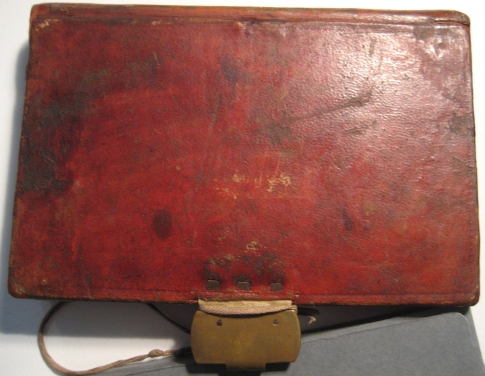
[inside back cover]
Charles Darwin
H.M.S. Beagle
September 1833
Buenos Ayres
A B / A C D
-1
-2
-3
-4
-5
-10
-15
-20
H9
Send
Dean Funes Historia1
owe 280 for coal to Lumb Harris? 2
Rowlett
1 Gregorio Funes (1749-1829), Dean of the Cathedral of La Paz. Funes 1816-17.
2 James Harris, an English sealer and ship owner of Del Carmen on Rio Negro who assisted Darwin and FitzRoy. There are many mentions of him in the Falkland notebook, the B. Blanca notebook, the St. Fe Notebook, the Beagle diary, Journal of researches and Narrative 2, especially the delightful episode during the voyage: "We afterwards heard, that the old major's suspicions had been very much increased by Harris's explanation of Mr. Darwin's occupation. 'Un naturalista' was a term unheard of by any person in the settlement, and being unluckily explained by Harris as meaning 'a man that knows every thing,' any further attempt to quiet anxiety was useless." P. 104.
[page 1b]
In the Rincon of Gordona near St Miguel many great bones also at Lorenzo Direction of Bookseller for Books
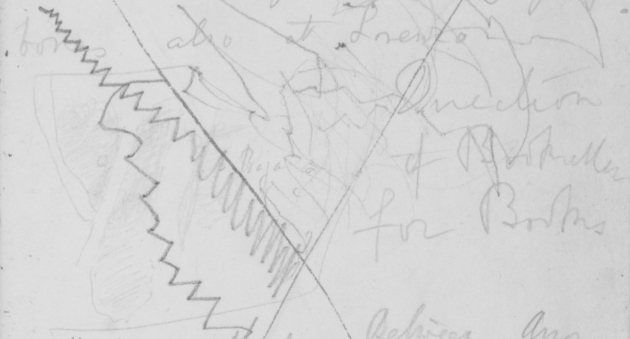 |
[sketch of dykes?] |
Baja
Shells about Between Arroyo1
St. Salvador & Agracindo. loose shells burnt for lime
Juan [Tate]. Boot maker. Mercedes
Calle de St Domingo. a Lady
Don Alexandre Martinez
Maestro Brownero —
Fossil bone [Pedazo del Mano] [illeg]
1 Stream or gully, also aroyo.
[page 2b]
R. Palmar. [Bugglen] Yerma Katers Compass Indigo [Yuquia] Banc. de Rozario Brown paper: Old Box Pix axe Bread. Yerba Sugar: Cigars Jar with Spirits [License] Fish hooks (Cart & Canoe 25 |500
20
[page 3b]
The Investigation of Guano on coast of Peru (Avica) interesting (Dung): — Indigo — Carmine. Sap Green good for [Mierloz]:1 infusion of black pepper & cinnamon // Boué Journal de Geologie t.II P.205 talks of Tertiary formations of
B. [P.] St Salvador.2 Epsom Salts at Melincue, Azara Salt between St. Fe & Cordova. Encyclopaedia Britt3 Helms4 (German Mineralogist travelled from B. Ayres to Lima: —
1 Possibly the same plant mentioned in Narrative 2: 166: 'A curious plant is found in Patagonia (and at the Falkland Islands), somewhat like a very large and very solid cauliflower. It is greenish, or yellowish-green, tough, and very abundant. It grows upon and close to the ground, forming a lump like a large ant-hill overgrown with moss and grass. From the succulent stalks of this plant a balsamic juice or sap exudes, which is particularly good for healing wounds.'
2 Boué 1830.
3 Encyclopedia Britannica.
4 Anton Zacharias Helms (1751-1803) German mining director in Peru 1788-92. Helms 1807.
[page 4b]
in 1793 Lightning struck Buenos Ayres in 37 places (killing 19 people in one storm. Encyclopaedia Britanica Molinas History of Chili1 To forward bones from Don Antonio [Rios] Set of Port Saws: 2 Tenon Saws — Joiner Hot Baths near 3 leagues Mendoza Letters to Chili
1 Molina 1794-5. Darwin acquired a copy when he arrived in Valparaiso.
[page 5b]
Molin[a] < >
[Move] < >
Bird < >
[Mol] < >
[can] < >
I [m] < >
Mention < >
Fish < >
[page 6b]
shoes & < >
one < >
Mao < >
Textual notes for the St. Fe notebook
[1a-60a] a hole was punched through these pages and bound with string. The knotted end remains through the hole in 1a only.
[2a] page not in Darwin's handwriting.
1.13] Down House number, not transcribed.
5] added by Nora Barlow, pencil, not transcribed.
88202333] English Heritage number, not transcribed.
[3a] there is a red stain, possibly watercolour paint.
[8a] Captain Robertson] ink.
[13a] level plain] ink.
[28a] :] ink over pencil in both instances.
[47a] ? The alluvium...del F.] added in ink.
[60a-64a] pages in ink.
[61a] M. Entre] in pencil.
[64a] Cordonese...Tosca rock] added pencil.
Caldcleugh Mastodon] added pencil.
[Perfect]...passes] added pencil.
[67a-215a] pages are stained grey, apparently from being wet and wiped dry.
[69a-70a] leaf has a tear in it, which has been repaired.
[78a] sketch and caption upside down from other entries.
[81a] there is a red mark after 'fragments.' which is possibly watercolour.
[90a-91a] sketch continues across following page, large watercolour stain mirrored on both pages.
[125a] sketch and caption written perpendicular to the spine.
= R2] ink.
[128a] sketch and caption written perpendicular to the spine.
[135a] sketch and caption written perpendicular to the spine.
[146a] sketch and captions written perpendicular to the spine.
[176a] sketch and 'E white… rocks". —' written perpendicular to the spine.
[179a] 37] crossed ink.
[194a] there are stains of two shades of blue watercolour.
[195a] there are stains of rust, three shades of brown and purple watercolour.
[206a] sketch and caption written perpendicular to the spine.
[216a] Cleaveland...45°] ink.
[222a] 600 ft] written perpendicular to the spine over 'saline'.
[223a] Sediment...rocks] ink.
[225a] lower right corner of page excised.
[226a] lower left corner of page excised.
[238a] page in ink.
[IBC] on the left edge of the page there is a 1/8 inch scale, written parallel to the spine, in ink.
owe 280...Harris?] upside down from other entries on page.
owe…Rowlett] written upside down from other entries on the page.
[5b-6b] leaf excised, two fragments remain.
[The Beagle field notebook identifiers were re-set in January 2021 meaning the page counters were reset to 0. At that time this notebook had 17745 visits.]
 REVISION HISTORY: Scanned by Historic England. Transcribed from microfilm by Gordon Chancellor; transcription typed and checked against microfilm by Kees Rookmaaker, 11.2006-1.2007. Pages 1a-90a were checked by Chancellor against the manuscript 11.2006. Editing by John van Wyhe 1.2007, corrected and edited against the manuscript and microfilm by van Wyhe 4-8.2008. Transcription revised and edited by van Wyhe 6-12.2008. Revised by van Wyhe and Chancellor 2024, 2025. RN19
REVISION HISTORY: Scanned by Historic England. Transcribed from microfilm by Gordon Chancellor; transcription typed and checked against microfilm by Kees Rookmaaker, 11.2006-1.2007. Pages 1a-90a were checked by Chancellor against the manuscript 11.2006. Editing by John van Wyhe 1.2007, corrected and edited against the manuscript and microfilm by van Wyhe 4-8.2008. Transcription revised and edited by van Wyhe 6-12.2008. Revised by van Wyhe and Chancellor 2024, 2025. RN19
 [section showing dyke]
[section showing dyke]



 [valleys in the Valle del Yeso] B B A
[valleys in the Valle del Yeso] B B A 


















 [section 'lofty hill']
[section 'lofty hill'] [section with heights]
[section with heights]





 [valley of Luxan]
[valley of Luxan]  [curved strata and section of road]
[curved strata and section of road] 
 Springs extends above
Springs extends above 



